& LARGE SCALE FARMER
Bold style of new Quadtrac flagship wins international design award
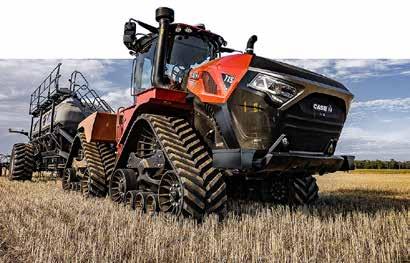
PROFILE
Tech and innovation are the kick


EQUIPMENT
John Deere introduces new S7 series combine harvesters NEWS

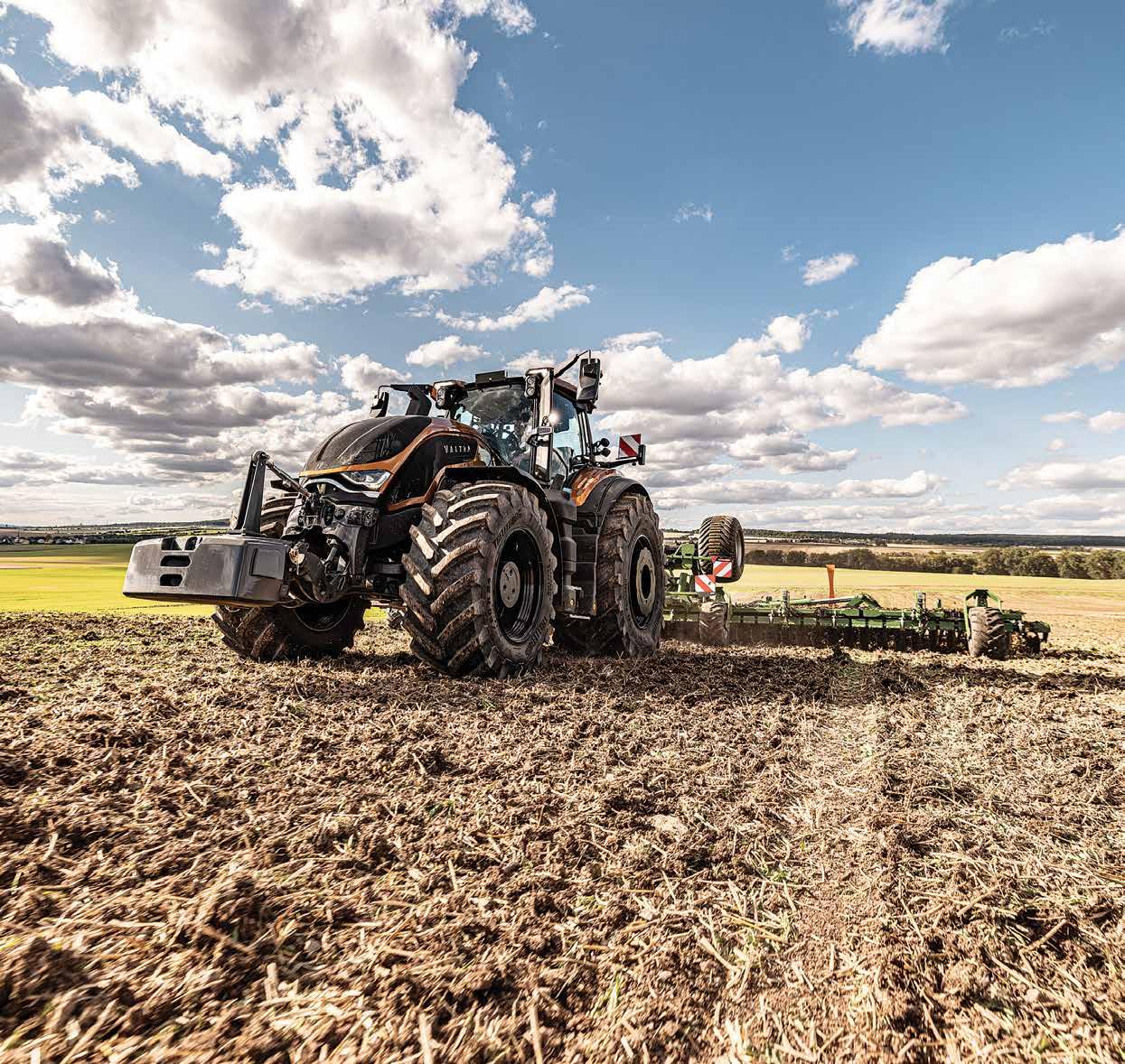
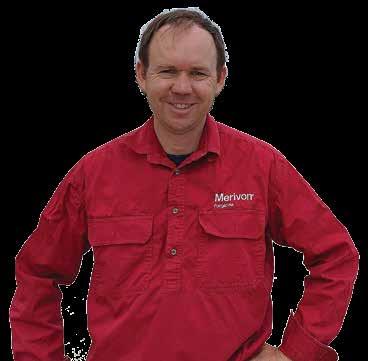
AUSTRALIAN ISSUE 142 MAY/JUNE 2024
FEATURE What’s new in Tractors 90hp+



The all-new Fendt 700 G7 is perfect for those with big plans. It features the latest innovations and technologies, and delivers unrivalled efficiency and performance. The FendtONE workstation, combined with intelligent vario drive and Fendt iD low-speed concept set this tractor apart from every other machine in its category.
Lead from the front with the Fendt 700 G7 Series.

Visit fendt.com/au or contact your local Fendt dealer to find out more.
Leaders drive Fendt.
fendt.com | Fendt ist eine weltweite Marke von AGCO fendt.com/au Fendt is a worldwide of AGCO
LATEST. GREATEST.
PUBLISHERS
AML, Ashcroft House
Tancreds Road, R D 2,
PO Box 37151, Halswell, Christchurch 8245
Ph: +64 3 329 6555 Fax: +64 3 329 6550
www.agrimedia.co.nz
Publishers of Rural Contractor & Large Scale Farmer, AgriBusiness, AgriVet, NZ Cropping, Australian AG Contractor & Large Scale Farmer, NZ Novachem Manual.
EDITOR
Scott Wilson
Mob: +64 21 725 061
Email: scott@agrimedia.co.nz
ADVERTISING SALES
Pulse – Media Sales
Justin Bowler
Ph: 0429 699 553
Email: justin.bowler@mmg.com.au
CIRCULATION
DDI: +64 3 329 6555
Email: admin@agrimedia.co.nz
PRODUCTION, LAYOUT & DESIGN
Mark Winstanley
Email: art@agrimedia.co.nz
Contributors: Delwyn Dickey, Gerhard Uys
Printed by PrintGraphics Pty Ltd
AC © AUSTRALIAN AG CONTRACTOR AND LARGE
SCALE FARMER - No part of this publication may be reproduced in any form without the prior written permission of the publisher. Opinions expressed in this publication are not necessarily that of the publisher and suggest independent advice be sought before acting on information or suggestions contained herein.
CONTRIBUTIONS - Editorial and photographic contributions are welcomed and should be sent directly to AML. Editing of submissions is at the sole discretion of the editor and will accept no responsibility for unsolicited material.
02 FROM
INDUSTRY NEWS
03 WA grower achieves precise seeding with new Bourgault 4420 DKD
04 Spreading the word about Australia’s world-leading precision farming
06 Reman helping farmers ‘do more with less’
07 Kiwi company announces eight row PTO-powered strip tiller
08 Ag Leader upgrade costs fraction of new or second-hand sprayer
09 Bold style of new Quadtrac flagship wins international design award ASSOCIATIONS
10 Make hay while the sun shines TECHNOLOGY
11 Automatic top link adjustment for smarter fert applications PROFILES
12 Tech and innovation are the kick
16 Tony Inder: Farming under solar panels
22 Across the ditch: Custom-built mulchers do the hard yards FEATURES
28 What’s new in Tractors 90hp+ EQUIPMENT
40 John Deere Financial ‘they know farmers’
42 John Deere introduces new S7 series combine harvesters
43 Pöttinger Vitasem: Proven technology with new details
44 John Deere announces new C-Series air cart lineup
45 Flexcare with Profiline comfort control system

47 TYM launches two new cabin tractors
48 Section control savings just the start at Bolgart
49 Kubota’s SVL75-3 loaded with new features
50 New ‘Intensive Mix System’ for Strautmann feed mixers
51 A legen-dairy life
52 Kuhn’s Axis fertiliser spreader offers operators precision spreading
THE EDITOR: Cultivating
in Australian farming 28 MAY/JUNE 2024
resilience
IN THIS ISSUE....
CULTIVATING RESILIENCE IN AUSTRALIAN FARMING
AMIDST THE VAST EXPANSE OF THE AUSTRALIAN COUNTRYSIDE, A SILENT REVOLUTION IS UNDERWAY.
Despite uncertainties of the climate, challenges across the economy, and consumer demands that seem to constantly increase, Australian farming is undergoing a remarkable transformation driven by resilience and innovation. This transformation is not only securing the future of agriculture but also positioning Australia as a global leader in sustainable farming practices.
Australia has long been synonymous with agriculture, but its farming landscape has seen dramatic shifts in recent years. The traditional image of rugged farmers battling the elements has evolved into one of savvy entrepreneurs harnessing technology and innovation to thrive in an ever-changing environment.
Central to this transformation are the individuals and communities embracing change and driving innovation on the ground. From precision agriculture to regenerative farming, forward-thinking farmers are adopting practices that not only enhance productivity but also promote environmental sustaina-
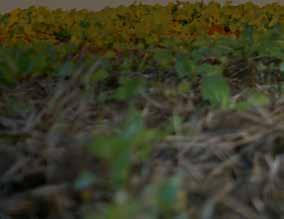

bility. By harnessing data analytics, satellite imaging and automation, they are optimising resource use, minimising waste, and mitigating risks associated with climate variability.
Australian farmers are increasingly diversifying their operations, exploring new crops and alternative revenue streams. The shift towards niche markets such as organic produce, native bush foods, and specialty grains is not only bolstering farm incomes but also preserving biodiversity and cultural heritage. By tapping into niche markets, farmers are cultivating resilience against market volatility while meeting the growing demand for sustainable and ethically produced food.
Additionally, collaboration and knowledge-sharing are driving forces behind the resilience of Australian farming communities. Through initiatives like farmer networks, research partnerships and community-supported agriculture, farmers are pooling resources, sharing best practices and collectively addressing common challenges. This spirit of collaboration is fostering a culture of innovation where ideas are exchanged, tested and refined to benefit the entire agricultural sector.
However, despite the strides made, Australian farming faces continued challenges,






 SCOTT WILSON
SCOTT WILSON
including climate change, water scarcity and market volatility. The resilience and innovation showcased by some must become the norm rather than the exception. Governments, industry bodies and stakeholders must work together to provide support, invest in research, and create policies that facilitate the adoption of more sustainable farming practices.
There’s little doubt that Australian farming is at a critical juncture, poised between tradition and transformation. The resilience and innovation demonstrated by forward-thinking individuals are reshaping the agricultural landscape, ensuring its viability in the face of unprecedented challenges.
As we navigate the complexities of the 21st century, Australian farming stands as a testament to the power of human ingenuity and the enduring bond between land and people.












The next generation. “SERIES2”
























































































INDUSTRY NEWS 02
goldacres
Goldacres Series 2 sprayers are Australian designed, engineered & manufactured sprayers for your farming enterprise.
WA GROWER ACHIEVES PRECISE SEEDING WITH NEW BOURGAULT 4420 DKD
DIRECTOR OF ROMA FARMING
COMPANY, A 30,000-ACRE MIXED CROP AND LAMBING OPERATION IN HYDEN, AND THIRD-GENERATION WESTERN AUSTRALIAN GROWER FRANK VARONE KNOWS PRECISE SEED PLACEMENT IS A MUST.
“We’re about 40% sheep and 60% cropping,” says Frank. “We mainly grow cereals, but also serradella for pasture.
“My Grandad started farming out here and we haven’t moved since. Dad continued growing the farm, and when he passed in 2005, that’s when I got handed the reins.”
During a visit to Bourgault Australia’s warehouse in 2022, Frank spotted a prototype of the soon-to-be new 4420 Deep Knife Drill™ and quickly volunteered for the role of ‘guinea pig’.
“We’ve always used Bourgault for our seeding,” explains Frank. “When I saw the prototype, I said to the Bourgault team that I’d be happy to trial it. I got to try it and really tested it out during the 2023 season.
“I was really impressed—so much so, I ended up buying it.”
Purpose-designed and built for Australian farms by the world’s leader in air seeding technology, the Bourgault 4420 DK ™ drill uses the latest advancements in farm machinery to enable growers to boost precision, efficiency and adaptability in their seeding operations.
The 4420 features an all-new frame design available in sowing widths of 12 metres and 18 metres with row spacings of 250mm and 300mm.

A major innovation of the 4420 is the dualtine DK ™ (Deep Knife) opener which penetrates the soil to greater depths, improving fertiliser separation, seed placement, and seed germination and growth.
Testing the 18-metre prototype bar to seed approximately 5,000 hectares of cereal crop, Frank was quickly impressed by the results.
“The bar I had before was an air hoe and just didn’t have the same level of precision,” says Frank. “If you had a leaking ram or something wasn’t adjusted right on the bar, your seeding was all over the place—sometimes a section of the bar would dig in deeper than the rest. The seeding was gauged by the tine itself, not by the press wheel.
“With the 4420, it doesn’t matter what the tines are doing, the seed placement is always precise.
WA GROWER FRANK VARONE PUTTING THE BOURGAULT 4420 DEEP KNIFE DRILL TO THE TEST.
“My germination was very even using the 4420, whereas, before it was very stripey and sometimes wouldn’t come up for a month because it was planted too deep.”
The 4420 also features an adjustable hydraulic breakout for on-the-go adaptability in varying soil conditions, resulting in consistent seed depth placement and uniform crop emergence.
The frame height is set via easily adjustable shims on the main frame cylinders that determine the working depth.
“All you do is take out a pin to adjust. With canola and serradella, I went shallower. With the cereals, I went deeper. Because the 4420 has good flotation, it’s very even and accurate across the whole bar,” says Frank.
“The best thing about the depth is you’ve got two sets of spacers on the front lifting rams, so all you’ve got to do is take spacers

03
SPREADING THE WORD ABOUT AUSTRALIA’S WORLD-LEADING PRECISION FARMING
INTERNATIONAL DELEGATION INSPECTS KUBOTA DSX-W
GEOSPREAD IDC FERTILISER SPREADER .
Australia’s world leading skills in precision farming have been put on display for an international delegation of research leaders in a special demonstration held at Melbourne Polytechnic.
Precision farming is the science of improving crop yields and substantiality by leveraging GPS and other technologies to support more efficient use of land, water, fuel, fertiliser and pesticides. The practice is used globally with Australia considered an international leader, performing the method at a large scale.
A delegation of 25 officials from Japan’s Kansai Economic Federation learned about precision farming from Kubota Australia during a firsthand demonstration at Melbourne Polytechnic.
The demo utilised satellite navigation technology to apply fertilizer to five hectares of pasture crops using a Kubota M7152 Premium KVT tractor and the Kubota DSX-W Geospread iDC fertiliser spreader.
The iDC spreader is equipped with a range of features to enhance precision, including an

out or in to adjust. There are no turn buckles or anything so it’s very easy to use.”
The 4420’s Hi-Flotation™ tyres, steerable front axle and floating hitch minimise soil compaction and provide optimal depth control for better precision on uneven terrain.
“The bar is very good for undulating country. It doesn’t matter what your tractor is doing, the

integrated hydraulic driveline to optimise border spreading.
Kubota Australia’s product manager of Kubota Implements, Mark Allott said the workshop is all about sharing Australia’s firstclass agricultural product innovations and precision farming expertise with the world.
“Precision farming in Australia fosters a more sustainable, efficient and profitable approach where Australia’s agricultural industry can save time and money across operations,” Mark said.
“Australia is a world leader in precision agriculture; the scale our farmers operate on is unmatched globally and Kubota is proud to be at the forefront of that practice.
“We are thrilled to be able to share our carefully cultivated knowledge with our friends from Japan.”
The demonstration displayed the latest innovations in on-farm satellite navigation technology and the intelligent functionality of the Geospread iDC spreader.
“Our demonstration showed
how farmers utilise their Kubota tractor and implements to apply fertiliser via a satellite receiver,” Mark said.
“First we mapped the area of application using satellite navigation to understand which areas required the most fertiliser, then as the tractor moved through the field the iDC spreader automatically adjusted the application rate based on a customised prescription map created by the farmer.
“This innovative technology not only makes it easier for farmers by saving on labour, it also boosts on-farm productivity and enhances cost-saving measures.
“The showcase of the new Kubota DSX-W Geospread iDC spreader was a highlight of the demonstration, with the possibilities of enhanced earnings and yield due to the excellence of the independent disc control.
The event highlighted the groundbreaking technologies behind Kubota Australia’s influential precision farming products and demonstrated their international capabilities.
bar will follow the ground,” says Frank.
Another key benefit designed specifically for the Australian market is the 4420’s narrow 5.5m transport width, applicable to both 12m and 18m models.
“The narrow transport width is good,” Frank explains. “It’s very compact and not very wide. It travels nicely down the road or
through gates and is safer.”
Bourgault Australia is committed to developing leading seeding equipment in partnership with growers like Frank to ensure the equipment stands up to realworld challenges.
“We bought our first Bourgault bar and drill in around 2000. Since then, I’ve had about five complete Bourgault units.
“The local Bourgault Australia
team have supported me all the way along.
“I like their equipment. I like how it’s put together. And I like that they’re in Perth so the service is good.”
Growers can purchase the new 4420 DK ™ drill for the 2025 season by contacting their local Bourgault Australia dealer. To learn more, visit: www.bourgault.com/en-au
INDUSTRY NEWS 04

Maximise Your Unloading Efficiency


UNLOAD UP TO 18T PER MINUTE!

Technologically Advanced Chaser Bins
The Elmer’s Haulmaster is a high-capacity, heavy-duty chaser bin with industry exclusive features and technology aimed at maximising operator unloading efficiency and increasing productivity.
Unloading speed exceeds any other chaser bin on the market with emptying speeds of up to 18T per minute
Powermaster Direct Drive Gearbox eliminates belts and drive chains increasing the auger output capacity for any given tractor power.
The Haulmaster Pro optional control system features a joystick for operating the chaser bin auger and spout and includes an autounload function and accurate load tracking.
4 way pivoting spout and adjustable auger allows for easy unload and accurate distribution of grains into trucks or motherbins.



AVAILABLE IN 30T, 36T, 41T, 46T, 55T & 63T CAPACITIES
SINGLE AXLE, TRANSFER TRACKS, TANDEM AXLE & FIXED TRACK OPTIONS
BOLT TOGETHER DESIGN FOR MAXIMUM DURABILITY
LEFT OR RIGHT FOLDING AUGER
3M WHEEL OR TRACK CENTRES FOR CONTROLLED TRAFFIC FARMING (CTF)
FULL-LENGTH HORIZONTAL AUGER FOR QUICK CLEAN OUT
PIVOTING
DRIVE GEARBOX
AUGER & SPOUT POWERMASTER DIRECT
HAULMASTER
CONTROL
PRO JOYSTICK
Proudly distributed by
Get in touch to secure your Haulmaster for 2024! Available Now
REMAN HELPING FARMERS
‘DO MORE WITH LESS’
TO
MARK GLOBAL REMAN DAY, THURSDAY 11 APRIL, JOHN DEERE SHONE A LIGHT ON THE POSITIVE IMPACTS OF ITS REMANUFACTURING PROCESSES.
An initiative of the Remanufacturing Industrial Council (RIC), Global Reman Day helps promote the environmental benefits of remanufacturing including waste reduction and conservation of materials, and economic benefits including reduced production costs and job creation.
John Deere Australia and New Zealand Director of Aftermarket and Customer Support, Emma Ford, said remanufacturing was a key component of the company’s mission to help customers do ‘more with less’ to meet the future demands of the industry.
“As input costs and the global population continue to rise, Reman is about much more than just replacing an engine,” Emma said.
“By 2030, there will be nine billion people on earth who will need to be fed, clothed and housed. At John Deere we believe we have a critical role to play in that.
“Offering remanufactured parts to our customers that reduce their environmental
JOHN DEERE’S REMANUFACTURING
CAPABILITY IS ON TRACK TO GROW 50 PER CENT BY 2030 IN LINE WITH THE COMPANY’S SUSTAINABILITY STRATEGY.

impacts and input expenses helps them meet these demands in a sustainable way.
“For example, not needing to produce a new engine or axle from scratch means natural resources are preserved, melting furnaces aren’t fired up, and carbon footprints are smaller.”
John Deere recycled nearly 12.5 million kilograms of material through Reman in 2022, with its remanufacturing capability on track to grow 50 per cent by 2030 in line with the company’s Sustainability Strategy, outlined in the 2022 Sustainability Report.
Emma said Reman Day is also an opportunity to educate consumers and producers on exactly what remanufacturing entails.
“‘Remanufactured’ is not the same as ‘rebuilt’ or ‘repaired’,” Emma said.
“A rebuilt part is disassembled only to the point of failure, and rebuilt using the same, new or aftermarket part. When a component is repaired, only the defective parts are examined and replaced.
“The remanufacturing process, by contrast, is much more involved. It’s not just about restoring functionality, but returning previously used, worn, or damaged parts back to like-new condition – like the part is totally reborn.

THE JOHN DEERE REMAN PROCESS BEGINS WITH A JOHN DEERE DEALER RECEIVING A DAMAGED PART AND SENDING THE ‘CORE’ OF THAT PART TO A CORE RETURN CENTRE. THERE IT IS COMPLETELY DISASSEMBLED AND THOROUGHLY CLEANED BY EITHER A BAKE OR CHEMICAL CLEANING PROCESS.
“We completely disassemble the product, thoroughly clean and inspect each part for wear or damage, replace where necessary and reassemble using the same processes we use to produce new components.”
The John Deere Reman process begins with a John Deere dealer receiving a damaged part and sending the ‘core’ of that part to the core return centre. There it is completely disassembled and thoroughly cleaned by either a bake or chemical cleaning process.
All parts are dimensionally verified against the latest John Deere parts specifications, and any part not meeting original factory specifications is either recycled or brought back to specification.
All wear-type parts such as pistons, liners, bushing, bearings, gaskets and O-rings are replaced 100 per cent of the time with new John Deere parts.
The product is assembled by highly-trained technicians to exact John Deere criteria. Finally, each product must pass a thorough inspection and testing process to ensure it meets or exceeds John Deere specifications, meaning it can be offered with a full warranty.
John Deere Reman only uses parts that are completely aligned with John Deere design and dimensions. In other words, no aftermarket or ‘might-fit’ parts are used.
On top of engines and engine components, John Deere dealers offer Reman parts including transmissions, fuel injection systems, electrical components, hydraulics and generators.
For more information about remanufacturing see your local John Deere dealer.
INDUSTRY NEWS 06
KIWI COMPANY ANNOUNCES EIGHT ROW PTO-POWERED STRIP TILLER
KIWI COMPANY PRECISION
CULTIVATION HAS ADDED AN EIGHT ROW VERSION TO ITS LINE-UP OF PTO-POWERED STRIP TILLERS.
Precision Cultivation strip tillers use both ripping tines and PTO-powered rotors to prepare 20 cm wide cultivated bands into which a precision planter can place the seed.
The new eight-row P6075F model is 6m wide and the rows are on 76.2 cm. It joins the four-row P3075, which is also on 76.2 cm spacings, and the six-row P3050, which is on 50 cm spacings.
Precision Cultivation managing director (and former contractor) Paul Linklater says with the global shift toward more sustainable farming, strip tillage can deliver both environmental benefits and cost savings.
“We designed our power-driven strip tillers based on our real-world experience in the agricultural sector. Strip tillage saves passes with the tractor.
“It also preserves soil structure, which enhances moisture retention and improves root development,” Paul says.
The design of Precision Cultivation strip tillers enables them to operate with significantly less horsepower than other powered strip tillers.
It has a single straight roller, which creates a smooth seedbed with no lumps between rows. Even in moist conditions, soil flows smoothly through the tunnels that house the rotary tillage units.
Wairarapa company Scott’s Ag Contracting supplies a range of harvesting and crop establishment services to arable, dairy, and sheep and beef farmers. Most years they also

grow 100 ha of maize silage on their own and leased land to sell.
Scott’s Ag recently bought a new eight-row Precision Cultivation strip tiller to match their eight-row Vaderstad Tempo precision planter.
Jason Scott says the company plants 500 or more ha of maize each year and he estimates they will do 150-200 ha of it with the strip tiller. The rest will be done with standard cultivation – plough, disc and power harrow.
“We used to do strip tillage seven or eight years ago but we were using a machine that only made strips with a cultivator shank. It did not suit conditions in the Wairarapa,” Jason says.
“The PTO driven rotary hoes on this machine can handle all the soils that we work in. With its eight rows, it gets through the

work. We have it set up with a front tank so that we can add fertiliser when we strip till.”
Jason says one reason his family and some clients are using strip tillage is to minimise cultivation passes and preserve soil structure. Another is to create better conditions for harvest.
“Paul Linklater did a couple of demonstration paddocks on our farm last year. Then we had a very wet harvest, and the only paddocks we could get the forage harvester onto were the ones that had been strip tilled.
“One of the paddocks we had run the strip tiller on got completely flooded. All the cultivated rows were washed out but not the interrows. If we hadn’t strip tilled it, the whole paddock would have been taken out.”
Scott’s Ag runs the strip tiller with a 345-hp John Deere 8R tractor. They use GreenStar guidance and an RTK correction signal from a network of base stations.
With the RTK guidance, they strip till and then come in the same day or the next day with the precision planter to hit exactly the same tramlines.
“The subsoiling leg gets down to 250 or 300 mm, which helps create good conditions for the rotary hoe to work effectively.”
Jason says generally they can do one pass with the strip tiller and then plant. If a paddock is compacted, they can do a pass with a subsoiler to promote good root structure for the maize and then come in with the strip tiller.
“Some of our clients are making good headway toward reducing the number of passes on their soils and they are keen to use the strip tiller. If you only cultivate half the paddock, that is the way to go.
“If you also have firmer footing when it comes to harvest and regrassing after the maize, that is another big bonus.”
07
AG LEADER UPGRADE COSTS FRACTION OF NEW OR SECOND-HAND SPRAYER
WESTERN AUSTRALIAN FARMERS STEPHEN AND ALBIE BOOKHAM HAVE UPGRADED THEIR 20-YEAROLD SELF-PROPELLED SPRAYER INTO A STATEOFTHE-ART PRECISION SPRAYER FOR A FRACTION OF THE COST OF A NEW MACHINE.
Their RoGator 1064 sprayer is one of the first self-propelled sprayers in Australia to be retrofitted with a RightSpot precision spraying system from Ag Leader.
RightSpot uses pulse width modulation (PWM) technology to ensure boom pressure remains constant regardless of operating speed. This ensures consistent droplet size, minimises spray drift and ensures the correct application of chemicals. By comparison, boom pressure in a conventional flow-based sprayer is determined by ground speed. Any reduction in speed produces larger droplet sizes and potentially reduces the efficacy
RIGHTSPOT USES PULSE WIDTH MODULATION TO ENSURE BOOM PRESSURE REMAINS CONSTANT REGARDLESS OF OPERATING SPEED.

of the product being sprayed, while any increase in speed will produce smaller droplets that are more prone to spray drift.
Stephen and Albie run a large scale cropping operation near Wongan Hills, WA. Over the past six years, the brothers have doubled the size of their cropping program to about 4000 ha of canola, wheat, barley and export hay.
This expansion has put pressure on every machine in their fleet, none more so than their ageing sprayer.
“Last January, the spraying system on the RoGator threw in the towel,” Stephen says. “It was finished. Nothing worked, the board had completely crashed and the wiring had short-circuited. We had no choice but to buy

a new sprayer or try to rebuild the old one.
“We’d just bought a new combine harvester, so we weren’t really in the market for a new sprayer. We were interested in getting a pulse width modulation system because we have lots of undulating country, irregularshaped paddocks and trees.
“With flow-based spraying systems, you have to maintain speed to maintain pressure, and that’s how accidents involving boom tips happen.”
A chance conversation with Doug Jeans, a precision ag specialist based in Perth, provided the way forward.
“Doug told us about RightSpot. It sounded exactly like what we wanted, so we got a quote,” Stephen says.
“We were quite surprised to find out we could get all the latest spraying technology for a fraction of the cost of a new or even a used sprayer.”
The system was installed in time for the 2023 sowing season and Stephen says they are happy with its performance.
“RightSpot is not just about being able to go faster but rather doing a better job at whatever speed you are travelling. We usually spray at about 27 kph but we know we can slow down if we have to without affecting the spray pattern.
“We have checked the spray pattern using blotting paper and the coverage is perfect whether you are doing 3 to 30 kph.”
STEPHEN BOOKHAM SAYS HE LIKES RIGHTSPOT’S AUTOSWATH SYSTEM, WHICH SHUTS DOWN NOZZLES AS THE BOOM PASSES OVER ALREADY COVERED SECTIONS, BOUNDARIES OR HEADLANDS.
Stephen particularly likes the AutoSwath feature, which eliminates over- or under-application.
It automatically shuts down each nozzle as the boom passes over previously-applied sections, boundaries or headlands.
Likewise, automatic turn compensation adjusts the application rate of each nozzle to ensure a consistent rate is applied right across the boom during turns.
He also likes the high visibility of the InCommand 1200 universal display, which provides onscreen monitoring of operating speed, boom pressure, droplet size, nozzle status and any diagnostic alerts.
InCommand displays have DisplayCast wireless connectivity, which automatically syncs and shares guidance lines, application and yield maps, operating data and satellite imagery with other connected machines and remote devices.
Application and yield maps can be transferred to Ag Leader’s SMS software and then combined with other farm data to generate prescription maps or crop plans.
INDUSTRY NEWS 08
BOLD STYLE OF NEW QUADTRAC FLAGSHIP WINS INTERNATIONAL DESIGN AWARD
THE RECENTLY-LAUNCHED QUADTRAC 715, THE NEW FLAGSHIP OF THE CASE IH TRACTOR RANGE THAT INTRODUCES A BOLD NEW LOOK TO THE TOP OF THE BRAND’S HIGHEST-HORSEPOWER CATEGORY, HAS WON ONE OF THE DESIGN INDUSTRY’S MOST RESPECTED GLOBAL PRIZES, AN IF DESIGN AWARD, IN RECOGNITION OF THE STRIKING STYLING AND PRACTICAL BENEFITS THAT IT BRINGS TO THE TOP END OF THE TRACTOR MARKET.
First presented in 1954, the iF Design Awards are acknowledged as one of the most respected design competitions, recognising the importance of product design across multiple varied consumer and commercial product categories.
Some 10,800 entries from 72 countries were entered for the 2024 awards, and the Case IH Quadtrac 715 was a winner in the Industrial Machine catego-
Products judged to combine innovative style and aesthetics with enhanced functionality are granted the iF seal, recognising their customer benefits while acknowledging the role of the design industry.
The styling of the new Quadtrac 715 sets it apart from established models in the Quadtrac range, underlining not only the tractor’s greater pulling power but also its ability to achieve even greater






new air intake grills to cool the larger, higher-output FPT Cursor 16L TST 15.9-litre engine, and features a new lighting design, with new LED road lights as well as new worklights that produce a total output of over 76,000 lumens delivering 11 per cent more illumination power. The styling forms part of a bon-
THE NEW CASE IH STEIGER QUADTRAC 715 HAS BEEN RECOGNISED IN THE GLOBAL IF DESIGN AWARD.
net that can be raised 31 per cent higher for easier service access and is opened and closed via an electric actuator.

09
*$5,000 factory rebate is only available on new Bobcat TL43.80HF telehandlers. Not available in conjunction with any other offers. Terms and conditions apply. For further details, contact Clark Equipment. www.bobcat.com.au | 1300 736 848 Distributed by
MAKE HAY WHILE THE SUN SHINES
THE AUSTRALIAN FODDER INDUSTRY ASSOCIATION (AFIA) HAS TODAY RELEASED A ‘FODDER RESEARCH, DEVELOPMENT AND EXTENSION STOCKTAKE’ REPORT HIGHLIGHTING SIGNIFICANT MISSED OPPORTUNITIES WHICH COULD SERVE TO ADDRESS DROUGHT PREPAREDNESS AND RESILIENCE ACROSS AUSTRALIAN AGRICULTURE.
“The report highlights that where fodder R,D&E is underway it is often fragmented, results and knowledge gained are not being broadly shared between researchers and agriculture sectors, and collaboration is minimal,” said Paula Fitzgerald, CEO, Australian Fodder Industry Association (AFIA).
“Fodder is a critical resilience tool, yet this appears not be broadly recognised,” she said. “In times of drought and flood, governments often take reactionary approaches to fodder particularly to support animal welfare needs, yet we believe the greatest opportunity exists outside of crisis times,” she said.
“It is understandable that fodder is often viewed through a specific commodity lens, but we believe there are benefits to be had in collaboration and the sharing of research outcomes.
“We need a critical mass ‘focus on fodder’ and recognition of its importance as a resilience tool. Despite significant funding for


drought preparedness, there appears to be minimal focus on the national importance of fodder and the critical role it plays,” she said.
The report’s 15 observations can be summarised in four key areas of opportunity:
- Make hay while the sun shines – identify mechanisms to encourage growers to make hay during ‘good times’ in preparation for challenging times such as drought and flood. The cost of de-stocking and re-stocking is significant (both livestock and genetics). De-stocking often occurs because of anticipated rising feed costs, yet if fodder was available on-farm, this cost could be reduced.
- Optimise opportunity – provide learning opportunities for growers to facilitate education on the best methods for cutting, curing, baling and storing hay, with a strong resilience focus in terms of producing a high-quality product (resulting in better nutritional value) and minimising pest attack. The past decade has seen a doubling of on-farm storage for grain, the opportunity is how to address this for fodder (hay and silage).
- Tackle low hanging fruit - identify the key elements causing hay fires and develop a ‘toolkit’ to manage and reduce this risk.
From the September 2023-February 2024 period, AFIA collated 48 hay fires across the country. Hay fires have significant impact in terms of fodder loss, infrastructure (sheds and machinery) destroyed, resources of emergency services personnel, and livestock in terms of reduced fodder availability. While some research is focussing on particular production points, there is a need for an ‘all of production cycle’ focus.
- New tools – encourage technology experts to work with the industry, utilising their skills, to develop tools which target industry priorities and in turn, reduce risk and improve confidence in the fodder sector.
“Some of the issues identified through the Stocktake Report, such as quality and hay
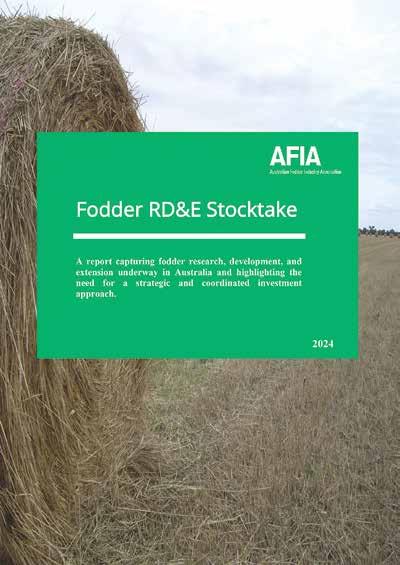
fires, have been largely left unaddressed for decades,” said Paula. “Now is the time to focus, invest and solve.”
“In addition to these report findings, we have anecdotal evidence from our members that fodder production carries with it greater risk, compared with the production of alternate crops,” she said. “This increased risk comes as a result of the time from production to sale (unlike grain, fodder is rarely sold ‘straight off the header’), fodder producers having to store and market the product themselves in a deregulated market, and the increased weather risk due to the curing window length.
“We believe this situation needs further assessment, as it comes at a time when dairy and livestock businesses are looking to grow,” she said. “A decline in fodder production, as a result of farmers choosing alternate crops, would present the broader agriculture sector with a significant challenge,’ said Paula.
AFIA would like to acknowledge Southern Farming Systems for funding to support this scoping project via the Drought Resilience Adoption and Innovation Hub program, and thank Dr Steve Thomas of ST Strategic Services for assisting AFIA in the compilation of this stocktake report.
10 ASSOCIATIONS AFIA AUSTRALIAN FODDER INDUSTRY ASSOCIATION
AUTOMATIC TOP LINK ADJUSTMENT FOR SMARTER FERT APPLICATIONS

ager Mark Hamilton-Manns says Valtra is nology to farmers and contractors, and this is



Smart Top Link improves the spreading accuracy of mounted fertiliser spreaders by automatically adjusting the top link’s length to ensure the spreader is correctly calibrated
mance of a fertiliser spreader, the operator has to adjust the top link’s length to ensure the spreader is level. As a result of extensive


SMART TOP LINK USES RADAR SENSORS TO MEASURE THE DISTANCE TO GROUND AND THEN ADJUST THE LENGTH OF THE TOP LINK ACCORDINGLY.




ability to significantly impact the accuracy and reliability of fertiliser placement.




reduces the negative effect by an average of

tal regulators are demanding accurate deliv ery and calibration of fertiliser spreaders,




Available as a Valtra Unlimited feature from the beginning of 2024, the system works via the SmartTouch display to keep a mounted
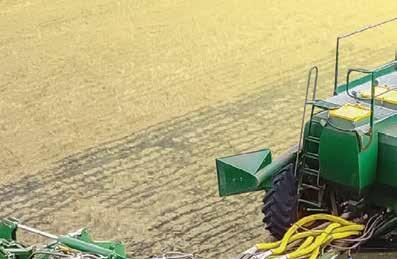


























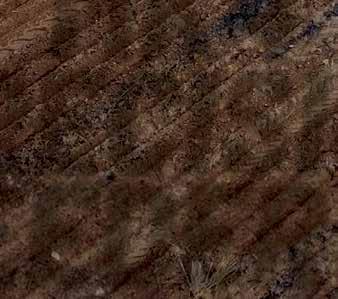
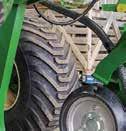




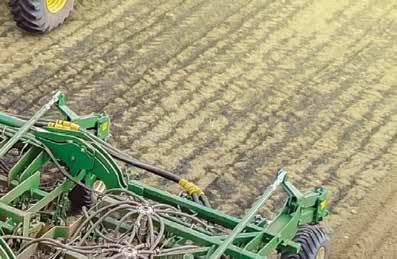






















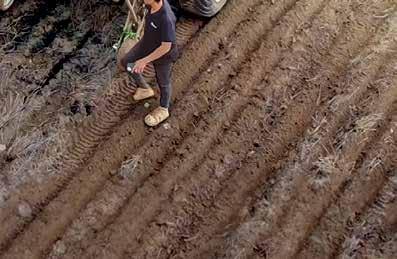







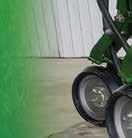




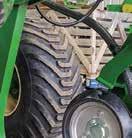




tra Unlimited on new N and T Series tractor TECHNOLOGY C M Y CM MY CY CMY K 2023-10 Mk4 Press Ad - AgContractor Full Page 297mm x 210mm-01.pdf 1 9/10/2023 3:25 pm C M Y CM MY CY CMY K 2023-10 Mk4 Press Ad - AgContractor Full Page 297mm x 210mm-01.pdf 1 9/10/2023 3:25 pm C M Y CM MY CY CMY K 2023-10 Mk4 Press Ad - AgContractor Full Page 297mm x 210mm-01.pdf 1 9/10/2023 3:25 pm
tech and innovation ARE THE KICK

HORSHAM ARABLE FARMER
TIM RETHUS IS A SELF-CONFESSED TECH AND INNOVATION JUNKY.
Not only that, his brother Luke has also caught the innovation bug.
Lucky for them their 5000-hectare dry land farm in the Wimmera region of western Victoria has plenty of farm, crop and tech problems to solve.
They have also built a reputation with manufacturers as growers that love to test gear.
Tim says the Horsham area is one of the more reliable dryland farming areas in Australia, and is flat, with good cracking clay soils that are free draining.
Rainfall per year is somewhere around 400mm, with about 300mm falling in the growing season and about 100mm in summer.
Long term average yields are about 3.2 tonnes for wheat.
TIM SAYS IF THEY KEEP THEIR GEAR FAIRLY UP TO DATE IT PAYS OFF IN THE LONG RUN AS THEY VALUE RELIABILITY FROM NEW EQUIPMENT MORE THAN MAINTAINING OLDER CHEAPER EQUIPMENT.
“That includes droughts where we get more or less nothing. But you can get seven or eight tonnes of wheat, if you do well. Most growers plan for five; if you get close to that you are very happy,”
Tim says.
The area was traditionally mixed farming, with sheep complimenting arable enterprises.
Initially wheat was the main crop, but later oats and barley followed.
In the 1980s peas were introduced, followed by canola and lentils in the 1990s.
“Lentils are a very big part of farming here. Our farm rotation is 1/3 pulses. That’s mainly
TIM AND HIS BROTHER HAVE BEEN WORKING WITH BILBERRY AND WRITING ALGORITHMS FOR CAMERA SPRAY TECHNOLOGY, SPECIFICALLY FOR VETCH AND LENTILS. BILBERRY CAMERA SPRAY SYSTEMS HELP FARMERS TARGET SPECIFIC WEEDS AND CAN GO GREEN-ON-GREEN AND GREEN-ON-BROWN.
lentils, but also faba beans and a few field peas. We can also grow vetch. Canola is becoming an increasingly large part of the region’s rotation. We’re up from

12
PROFILE

THE BROTHERS RUN A TRIPLE MOWER ON 40FT CONTROLLED TRAFFIC LINES, AND USE A QUADROTOR ROTARY RAKE TO FORM 40 FOOT WINDROWS FOR BALING.
about 10% of our farm area in canola to over 25%.”
Tim’s grandfather Gordon moved to the Horsham area in 1947 and “came down for more rain”.
He ran a sheep and cropping operation.
Tim says the need to explore new technologies was probably passed down from his grandfather.
Gordon was one of the first farmers to have a self-propelled combine harvester in the area.
“It was a bit of a novelty, but was terribly unreliable. He went back to an old pull type, but that innovation drive was instilled in his sons.”
Tim’s father, Geoff, and his uncle, Nevan, took over the farm and expanded cropping.
In 2000 they decided to go no-till and control traffic, using a 40ft single disc seeder, 120ft self propelled boom spray and 40ft harvester on 15” row spacings.
“They were almost fanatic,” he says.
Controlled traffic farming is a method that reduces the damage to soils caused by heavy or repeated agricultural machinery passes. It uses permanent wheel tracks with permanent crop zones and traffic lanes made possible with high accuracy GPS guidance.
Tim says no-till freed up a lot of man hours on the farm by reducing tillage passes and using wider equipment.
Geoff and Nevan followed
no-till principles since the 1980s when they practiced minimum tillage with knife points at seeding and stubble retention, he says.
None of Nevan’s children came back to the farm, but Tim and one of his brothers did.
Tim studied chemical engineering, his brother Luke studied telecommunications engineering and worked as a telecommunications engineer while his older brother studied accounting and his sister Jacinda is a doctor in microbiology.
After eleven years of working at Shell Oil as a refinery process engineer, Tim came back to the farm.
The innovation and exploration bug might already have bit him before he started farming.
“The thing about process engineering in the oil business is that you have to infer a lot from data because you can’t physically touch anything. If you have any leaks it catches on fire and everybody dies. You’re trying to work out what’s going on in reactors and distillation columns. We had lots of spreadsheets. I love Excel. It’s one of my favourite programs,” he says.
Brother Luke also came back to the farm and is also tech savvy.
“He’d been working at Telstra as a project solutions specialist. He has had the internet since the 90s. My mum used to work for the government and he was beta testing Netscape Navigator at home for them when he was in high school. He’s a telecommunication engineer; like all engineers, they just solve problems.”
Problem solving is now applied on-farm, with the brothers trying to fix “bottlenecks and frustrations” when they can.
To solve problems in farming,

cooperation is needed with machinery manufacturers, Tim says.
Working with industry to solve problems can benefit both parties. Constructive feedback on new tech will lead to more suitable farmer orientated products.
“If they’ve got something new they might actually come to us, because they know they’ll get constructive feedback. We can get in early and help set the discussion and ensure solutions suit our farming practices which are typical in this region.”
Being part of a positive discussion means the brothers can also consult developers that might sit in cities, and advise them how a product can be economically viable on a farm or be designed so farmers will use it.
Tim has many examples of how on-farm innovation and collaboration with machinery manufacturers come together, often not only leading to on-farm changes but to changes of how machinery is manufactured and used in the industry.
A collaboration with BPW, who
THE RETHUS BROTHERS RETAIN STANDING STUBBLE AND USE CONTROLLED TRAFFIC METHODS.
manufacture axles, shows how working together solved a real problem.
“We grow oaten hay on 40ft controlled traffic lines. It took a while to get a setup that works.”
The brothers run a triple mower on 40ft controlled traffic lines, and then use a quadrotor rotary rake to form 40 foot windrows for baling.
However baling was a problem as balers are built on a narrow axle width to suit European conditions and would otherwise not fit their fixed 3m wide controlled traffic tramlines.
The baling woes were only solved when they spoke to the right people who have the right mindset, he says.
Tim met up with BPW axle manufacturers at a local field day and regaled them with his baler woes.
“They were like, yeah, no wor-
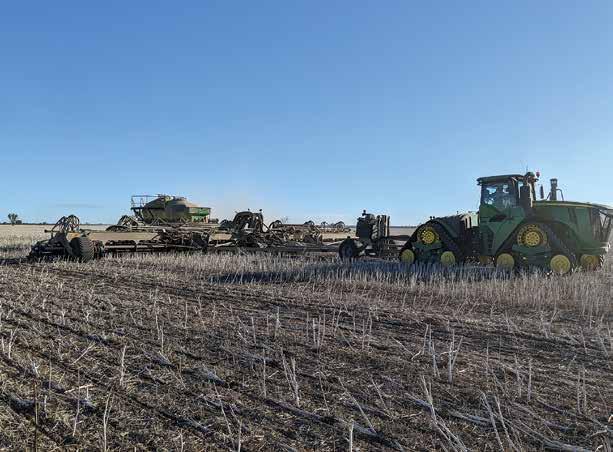
A CUSTOM 24M TWIN-DISC AIR SEEDER SOWS GRAIN, GRANULAR FERTILISER AND APPLIES LIQUID IN THE FURROW. THE LOW DISTURBANCE MINIMISES WEED SEED GERMINATION AND IT USES GPS CONTROLLED TOOLBAR FOR INTER-ROW SOWING. “WE’VE BEEN OPERATING AND TUNING THIS CUSTOM UNIT FOR 7 YEARS.”
13
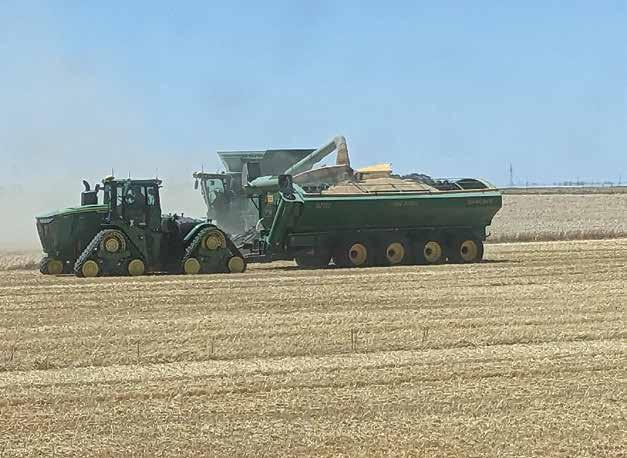
HARVESTING BARLEY AND UNLOADING ON THE GO INCREASES THE EFFICIENCY OF THE JOHN DEERE COMBINATION (JOHN DEERE X9, WITH 40T OZTEC TRAMALINER ON A 9RX TRACTOR).
ries. We’ve got the blueprints for the baler. We’ll run it through the engineering department. They came back and told me what I needed and sent a crate with a couple of axles and mounting brackets. We jacked it up and swapped them out. They’re steerable and braked. They’re also engineered for the weight. All of a sudden, you’ve got a control traffic baler.”
Besides solving an on-farm problem, such a collaboration also opens the minds of manufacturers and makes them ask
TO BUILD THE SOIL MICROBIOME AND CARBON TIM SAYS GOOD NUTRITION AND CONSIDERATE FARM PRACTICES SUCH AS STUBBLE RETENTION IS KEY.
the question whether such a niche solution should be more widely available, he says.
Another example would be getting an air inflation kit on a Agrifac boom spray.
The brothers were wearing out tyres due to operating at low tyre pressures for field work to minimise compaction and protect tram lines, but then having low tyre pressures for road work causing higher wear.
They approached Agrifac and asked them to fit an air inflation kit for the boom spray to allow low tyre pressures for field work, but high pressures for road work to increase tyre life.
Agrifac fitted an aftermarket kit at their factory.
“Now at least 30% of Agrifac boom sprays are purchased with air inflation kits,” Tim says.
Tim says their proximity to a larger town has helped, and the farm often hosts researchers, or manufacturers.
“Once people know you’re willing to try new products or techniques then your name gets around. We keep our equipment relatively new and value reliability from new equipment more


than maintaining older cheaper equipment. We are often keen to take on updated or different equipment that could help us solve one of our farming problems.”
Tim, for example, worked with an early version of a harvester protein metre to map protein.
This is part of their strategy to optimise yield across a field using variable rate techniques.
“You have to be constructive [with criticism]. Manufacturers get excited when they have a good contact in the field,” he says.
Mindset plays a role when testing new gear, he says.
“Don’t try and force your old methodology onto a new product. Try and use it like the manufacturer designed it to be used and be open to that. People often feel comfortable if a new car drives like a newer version of their old car. Getting outside your comfort zone and doing things differently can be hard, but in the end could be better.”
Besides feeding their gear junky addiction through collaboration and problem solving, Tim and his brother have been working with Bilberry and writing algorithms for camera spray technology, specifically for vetch and lentils.
In a lentil growing area like the Wimmera, vetch is a problem weed in lentils and a key contaminant in harvested seed.
Because vetch and lentils are so similar genetically, controlling with selective chemistry is very challenging.
“Vetch has purple flowers and lentils have white flowers. Bilberry came out to the farm and took photos and began building a database. We started a trial last year to selectively spray vetch plants in lentil crops, which
SELECTIVE SPRAYING WILL OVER TIME LEAD TO A REDUCTION IN WEED SEED AND REDUCED HERBICIDE USE.
over time will lead to a weed seed bank reduction and reduced herbicide usage,” Tim says.
The brothers also control issues with wild oats in wheat paddocks.
With the wild oats having been part of the farming landscape for decades they have become resistant to many herbicide options.
Bilberry helped and built a system to detect heads of oats in wheat crops.
Such a niche spot spray product means a seed bank of unwanted plants can be destroyed when it is controlled over a long period.
Working with smaller companies, such as Bilberry, is often easier as they are in a growth phase, Tim says.
“We love new technology and we like looking for new fixes to problems in our farming system. We like to work with people and create workable solutions and that’s what we get the most thrill out of. Our advantage is identifying problems and knocking out new solutions. Having been outside the agriculture industry in our past engineering careers means we came back in with a fresh set of eyes.”
Tim says their main vision is to be sustainable in the way they work.
Sustainability means many things.
Using machines, like John Deere’s X9 combine harvester, which uses less fuel per hectare than the series below it, and reducing tillage practices, saves
PROFILE
14

on fuel and is a way to get ahead of fuel increases and keep the business sustainable.
The brothers focus on soil health, but are not fanatical about it.
“We retain standing stubble and use controlled traffic methods to decrease compaction and maximise water use efficiency which is our critical yield limiter.”
Although practising many regenerative agriculture techniques, they don’t agree with some of the regen principles that suggest you get something for nothing, such as cutting your nitrogen, which studies show is greatly under-applied in their low N loss environment, but then miraculously getting more organic carbon and higher yields.
“It is not a one size fits all principle across regions.”
When applying fertiliser the principle of “soil biology eats nutrients first” applies on the farm.
“When you grow a crop and apply nitrogen you have to factor that in. If you plan to build your soil microbiome and build carbon you have to treat it like a grain crop and manage it appropriately with good nutrition and considerate farm practices such as stubble retention.
“By targeting a higher soil function through adequate nutrition, the soils and the plants will be more resilient to our variable seasons. Soils are releasing nutrients to plants in good years to satisfy high yields. And in poorer years, it’ll just be stored.
The benefit of that is that we have crops that give us longer windows that allow more applications to happen on time such as fungicides, or fertiliser applications.”
CHALLENGES
Tim says there are many challenges that the industry is facing.
Labour and the rising cost of land is a challenge.
The key one is getting quality labour, with truck drivers a good example.
“It takes years to get a multi-combination truck licence, but by the time most young people get it, they often want to move on. People are not as beholden to their job anymore. So they don’t get that expertise, and they tend to move sideways rather than step up to higher responsibility roles.”
High land costs not only make it harder to enter the industry or expand, but also drive leasing rates and reduce farmer margins while increasing risk levels.
Prices per acre have in some instances touched $15,000/acre, with $10,000/acre common, he says, up from about $1500/acre 15 years ago.
“That is pretty high when you’re averaging three and a half tonnes of wheat per hectare,” he says.
On the innovation front, finding the right fit for artificial intelligence such as autonomous vehicles in future will be key.
“How will autonomy work in a broadacre setting? Autonomous chaser bins or summer weed spraying could be a great
fit. So too would autonomous grain trucks. But is it a good idea for field work like in crop spraying? During this task a farmer observes the whole field and can make decisions about future actions, while at the same time maintaining equipment performance and being there for unforeseen problems such as equipment failure. Field observations can be done via drone but then the farmer is no longer
out in the field but behind a screen in an office.
“The best fit for autonomy is to do the jobs we find tedious and not as value adding. This will change over time as confidence in the technologies improve and new tools are developed, hopefully with our input.”
But for Tim and his brother, this is all part of why they farm, solving the problems and seeing change happen.

15
TIM POSTED THIS PHOTO ON X (TWITTER) TAKEN BY A FRIEND WITH THIS CAPTION, WHICH SUMS IT ALL UP: “DUST AT NIGHT, PHOTOGRAPHERS DELIGHT. BIG BIOMASS, GOOD YIELDS, LOTS OF DIESEL, SLOW GRIND.”
Swift lubrication from accessible centralized grease bank Quick crop change over using horizontal auger cleanout doors Kinze Harvest Commander Chaser Bins designed and built to work hard all day, every day. Confident and smooth unloading using the precision tip spout
WORK HARD. YOUR GRAIN CART SHOULD TOO. For more information, contact sales@kinze-export.com
YOU
tony inder: farming UNDER SOLAR PANELS

A CHAT AT THE LOCAL PUB HAS LEAD TONY INDER AND HIS FAMILY DOWN A SURPRISING NEW FARMING PATHWAYAS SOLAR GRAZERS.
A GOLDEN OPPORTUNITY
Tony is a sixth-generation sheep farmer. And, at 54, his whole career has been spent around sheep and wool. First as a shearer for 15 years, doing contracting on the side, until he and wife Penny eventually bought a 2000-acre sheep farm near Wellington, 50 kms west of Dubbo in New South Wales.
He reckons between shearing and contracting there’s not many properties within a 100 kilometre radius that he hasn’t worked on at some point.
While Penny has always worked off the farm as a nurse and now manages a nursing unit at a private hospital at Dubbo, Tony runs the farm operation and has become a merino breeder as well as running a commercial flock.
The farming area around Wellington has seen some big chang-
TONY - IN THE LIGHT SHIRT - AND PENNY STILL REGULARLY SELL THEIR RAMS.
es in recent years due to interest from various solar companies with the area planned to be part of a renewable energy corridor carrying power to the high electricity demand urban areas on the east coast. This saw another TransGrid power line planned which would cut through the area. Bigger solar farms need to be fairly close to substations on
RUNNING SHEEP UNDER SOLAR PANELS HAS BROUGHT BENEFITS AND CHALLENGES FOR TONY INDER.

16
PROFILE
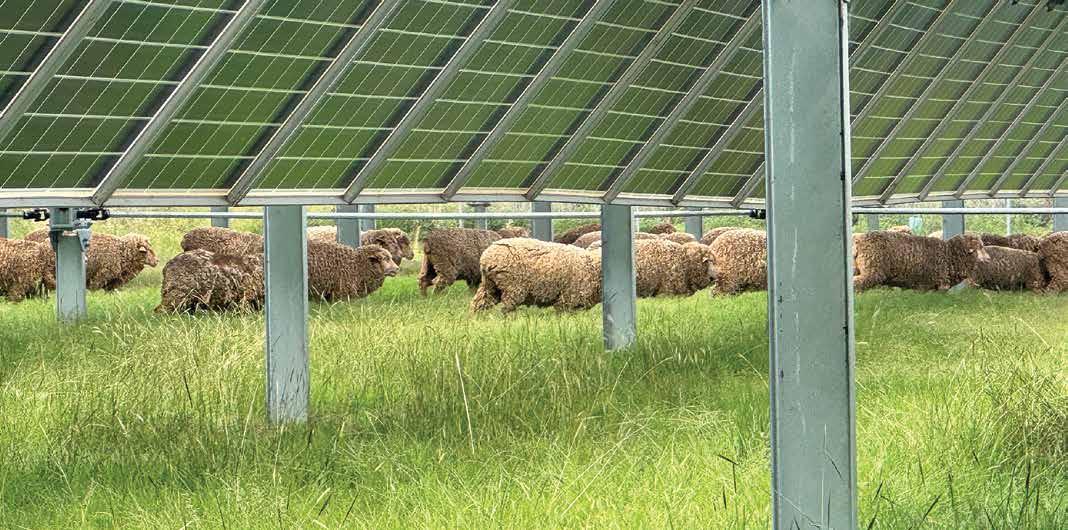
these major power lines for them to be commercially viable. Initially there were several pathways the new power line could take and there were a lot of farmers being approached and offered holding agreements on their land ahead of the exact route being confirmed.
Once the route was officially confirmed, sales and leasing of land kicked in and infrastructure for the solar farms got underway.
Tony and Penny had been approached by several groups looking to get a holding agreement on their land but had turned them down as their holding fees were small or non-existent. Lightsource BP offered them a substantial holding fee and they had decided to sign with them.
LAWN MOWING SHEEP
When their neighbour sold
their 1500-acre farm to Lightsource BP four years ago, construction began on solar farm infrastructure that would cover 1000 acres of the farm.
While farming continued as usual for Tony he kept a keen eye on what was happening next door as the photovoltaic panels went up.
One thing that really struck him was how green the grass under the panels was, even in drier weather.
Average rainfall in the area is about 600mm of rainfall annually although that can range anywhere between 200mm to 1500mm Tony reckons.
“On my farm it would stay green for a week or so and then it dries off and then it’s gone,” he says. “But it stayed green under the panels.” This got Tony thinking this could work well for grazing sheep.
While chatting to one of the managers of the solar farm down at the pub one day, the cost of keeping the grass under control came up. It needed to be kept shorter than the fire hazard restriction height for grass in NSW, as well as low enough it wouldn’t shade the panels.
Six to eight ride-on mowers were being used by the solar farm to keep the grass down and would be on site for weeks. This was costing them $90,000 a pop with mowing planned six times a year.
Tony suggested his sheep could do the job and would be a cheaper option.
Tentatively given the go ahead, the sheep have turned out to be a win/win for both the solar company and for Tony.
Four years on and Tony is running 2000 dry sheep under the panels. Mowings have reduced
to just twice a year with a light broad leaf spray heading into winter (when they germinate) with the sheep eating out the broadleaf over winter.
“I thought they would adapt to panel life, but they have thrived,” he says.
They seem happier Tony reckons as they can easily get out of the sun and into the shade of the panels during the warmer months when the temperature can hit 45 degrees C. The panels also offer shelter in wet or windy weather and the -5 degrees C cold in winter - all while staying green underneath.
There are a couple of creeks on the land which have water running for much of the year that the

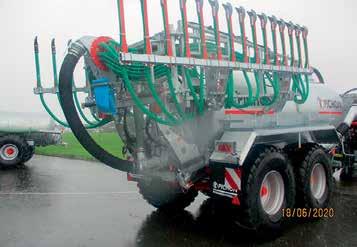
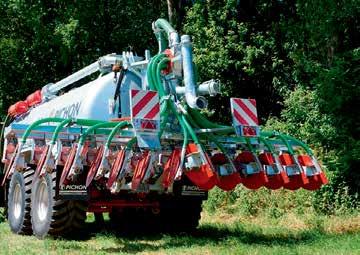
17
GREEN PASTURE UNDER THE PANELS SAW TONY LOOK AT GRAZING SHEEP.
Tom Paltridge 0419 851 543 www.muckrunner.com.au QUALITY GALVANISED EFFLUENT HANDLING MACHINERY Liquid manure spreaders with your choice of delivery system. Tine or disc direct injector Trailing shoe Dribble bar Splash plate

sheep can access. There are also water tanks onsite, for washing down the panels, which can be used for the sheep in the driest months.
ADAPTING TO FARMING UNDER THE PANELS
While the operation is fairly straight forward, Tony has changed some practices to manage the sheep in what is basically one big paddock.
This is partly to do with difficulty getting machinery between the panel rows and the way the sheep mob up differently under the panels, making conventional mustering difficult.
Using dogs also wasn’t an option in the early days, although as the solar farm managers have become more confident in the sheep grazing operation, they are now allowing farm dogs on site when necessary and seem more open to the idea of potentially adding internal fencing to make life easier.
Different solar farms can have different turning mechanisms for the panels.
On this one, the rows of panels are in blocks covering about 30 acres, with a single shaft to turn the panels so they follow the sun during the day, which runs from the centre front row to the back cutting through the rows. Every 15 minutes, the shaft starts up and turns for 15-20 secs, to rotate the panels a little. Running about knee height the shaft means you can’t get a vehicle all the way along the rows. The mowers have zero turn and mow along the row till they get to the shaft then turn around and come back again.
The sheep know vehicles can’t get all the way through and this makes mustering difficult.
Added to this is the moving panels see the sheep spread out all over the site instead of loosely mobbing up together.
“Sheep graze as a social mob but under the panels, while they may be in a mob to start with, as the panels tilt they’ll look up and they can’t see their mates and wander off in different directions,” Tony reckons.
“By the end of the day they’re grazing in smaller mobs from 50 to 200 scattered all over the solar farm.”
Tony admits trying to muster in the first 18 months was a drama as he learned to adapt to the sheep’s new behaviour.
The key was the sheep always coming back to the one spot to camp at night – a hill.
Tony now uses this camping site as his yarding area, bringing in portable yards and a loading
race when he wants to take the sheep off.
“We’ve got until about 8am as the panels stay flat overnight and then slowly start to tilt once the sun comes up. By 8.30am they’re tilted right over to get the morning sun, and you can’t see – there’s maybe only a foot off the ground in places when tilted right over.”
Tony is now able to get all of the animals off like this - but it can take several days. While he can generally do it in three days now, when he first tried it was taking four or five days. “We’ll get 80 percent the first run, 15 percent the next, then the final five percent and we’ve got them all.”
But there is a negative side to this slower move off the land.
“If there’s a worm infestation, or a fly wave comes through with fly blown sheep, you can have trouble getting in to get them out. If they’re the weak and ill ones, they’re not going to mob
THE SHEEP TEND TO SCATTER INTO SMALLER MOBS DURING THE DAY.
up with the others.”
To overcome this Tony has opted for prevention using more and longer acting chemicals with drenches and fly treatments to stay in front of it.
“On my own place I might use a drench that’s out of their system in seven days, and that means I can sell that animal in 20 days if I need to. Under the panels, I use a drench that’s going to last 120 days, but won’t be able to sell the sheep for 140 or 170 days.”
But Tony is comfortable with that as, once they’re on site, they’re there to stay.
“The sheep are there to grow wool and nothing else - and are not being sold.”
For ease of management, the sheep under the panels get shorn every six months. Replacement animals are bred off-farm to replace the older ones each year.
He’s had some positive discussions with solar management recently about building a set of yards there, a loading facility, and fencing a couple of little holding paddocks off so he can better manage the sheep.
While the solar managers knew nothing about sheep and sheep grazing, Tony is pleased they have come on board and are trying to embrace it. They have a good working relationship
WITH NO FENCES THE SOLAR FARM IS ONE BIG PADDOCK.

PROFILE
18
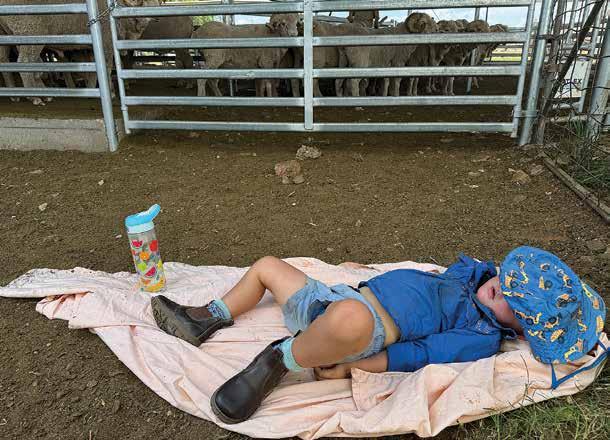
THREE YEAR OLD GRANDSON OSCAR IS A REGULAR AT SHEARING TIME.
he believes, with management open to fairly much anything he thinks will help with livestock management.
With the land originally unimproved pasture, there is now a higher stocking rate of sheep with more improvements being planned by Tony.
He is just starting to discuss
the possibility of sowing higher protein nitrogen-fixing legumes under the panels which are also naturally lower growing than grasses, and getting an apiarist on site with bee hives as he has on his own farm.
AN EASIER LIFE BRINGS REWARDS
Security measures to keep the site safe have seen 8ft wire fences with barbed top wires erected with Tony needing a code to get in. Along with no-one being able to poach his sheep, the fence

has the added bonus of keeping out wild dogs which have been turning up around the area more regularly, with Wedgetail eagles also unable to get at sheep under the panels.
Because the solar sheep have an easier life under the panels, Tony says their wool is a lot better.
“At shearing time, you can get a break in the wool fibre and you can tell that’s where there was a dry period and the sheep had a bit of a setback. Under panels the strength of the wool is sounder –
THE SHEEP COME OFFSITE FOR SHEARING EVERY SIX MONTHS.
they don’t cop the extremes.”
The constant easier growing conditions for pasture may be having a positive effect on the microbes in the sheep’s gut.
“There are five or six different weather periods over an entire year that sees the microbes constantly adjusting to different pasture. As grass under the panels is always green the gut



19

doesn’t have to adjust nearly as much – its one level plane of nutrition.”
This has seen Tony and solar management get some research under way to see if they can nail down some solid data to confirm this. Trialling has seen a mob running under normal conditions outside the panels. When shearing rolls around they are collecting data on random sheep from under the panels and all the ones running outside the panels.
Fleece weights, microns, wool length and staple strength are all being looked at.
There are some negative perceptions around good quality agricultural land falling out of
PANELS OFFER SHADE IN SUMMER, AND SHELTER FROM WIND, RAIN AND WINTER COLD.
production when solar farms come to town. Showing agrivoltaics – agriculture and solar farms – can successfully combine and potentially improve farming outcomes would likely allay some of those concerns. And potentially see agrivoltaics/ dual land become mandatory.
His own experiences with his sheep under the panels sees Tony wanting fencing or at least the potential to fence become mandatory for solar farms seeking consents.
“We’re in the position now where we’ve got this farm and they’re not really game to fence anywhere, because you don’t want to drive a post where a cable might be. With merino sheep an electric fence isn’t ideal as the wool acts as an insulator and they don’t actually get the zap they need. So potentially they could end up everywhere anyway.”

As they settle in to this new normal with solar grazing, the future is looking very different for Tony and Penny. They have now sold their farm to Lightsource BP and moved into Wellington.
Tony reckons this was to preempt their three daughters Jessica, Amelia and Imogen bailing him up in 10 years’ time to bring their mother into town.
The commercial operation has now moved to a new property they bought 50km away near Gollan with Tony traveling to and fro.
The enlarged solar farm, with development on their old farm now under way, will see 2000 acres of panels.
Tony is hopeful he will be running his sheep in there by the end of the year with potentially around 7000 dry sheep equivalents raised on their new property and running under the panels
across the larger site.
Tony was recently a guest speaker with other larger scale solar grazers from the UK and the US in a webinar by rural consultants Anna Vaughan and Prof. Alan Brent – Sustainable Energy Systems (with funding from Our Land and Water National Science Challenge) – giving their experiences of sheep farming under panels and aimed at New Zealand farmers.
Large solar farms are also being developed in New Zealand with agrivoltaics/dual land use now common as part of the consenting process. For more info please visit https://www. youtube.com/watch?v=qEWJr_3_97Y
TONY: THE QUALITY OF WOOL COMING OFF THE SOLAR SHEEP IS BETTER.

PROFILE
FLAT OVER NIGHT THE PANELS START MOVING TO CATCH THE EARLY SUN AT DAY BREAK.
20
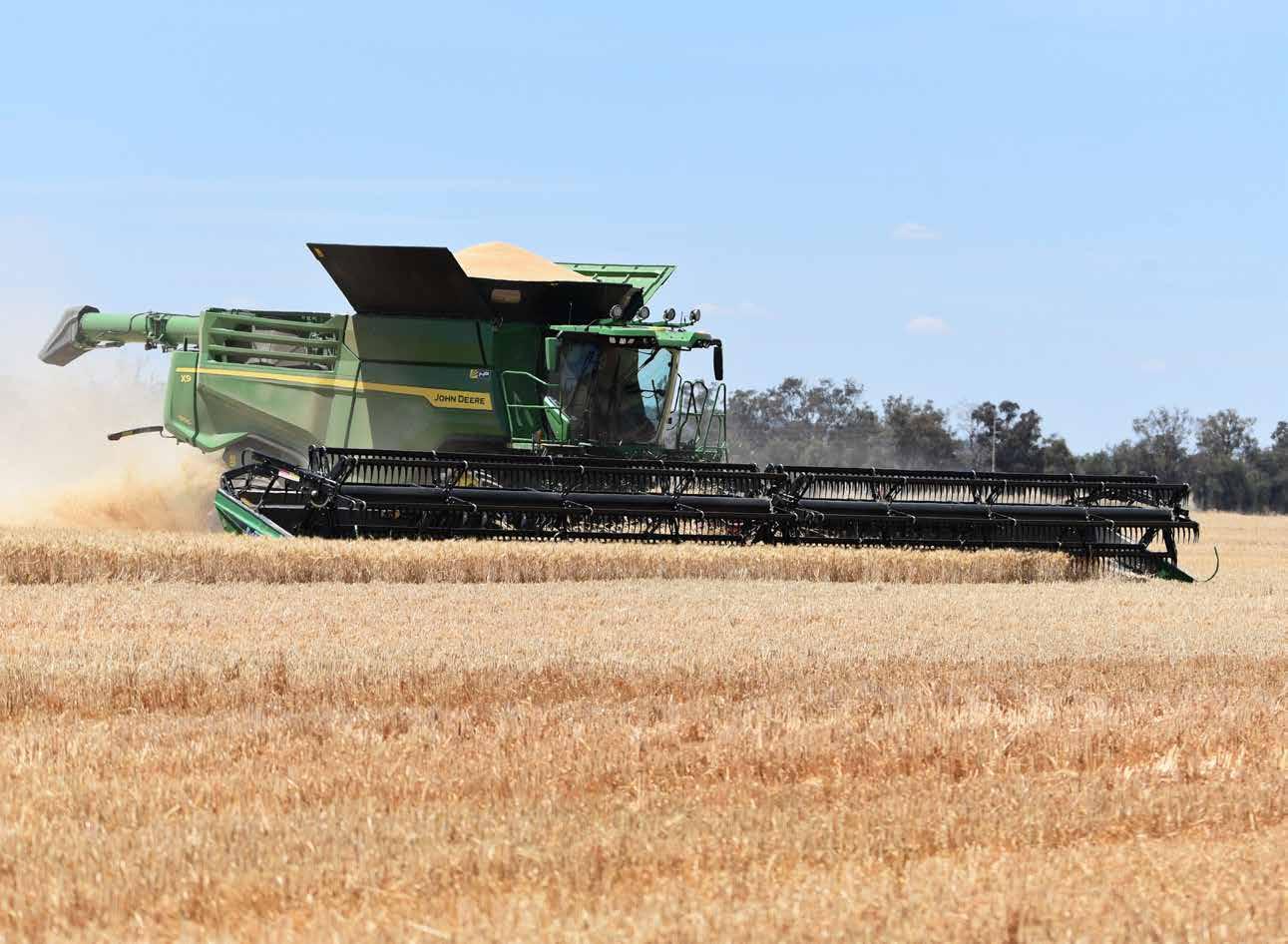

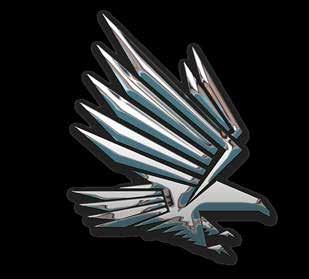



UNLEASH YOUR X9 COMBINE’S FULL CAPACITY WITH THE ONLY AUSTRALIAN MADE DRAPER PLATFORM. PROUDLY AUSTRALIAN MADE. MADE BY AUSSIE FARMERS, FOR AUSSIE FARMERS. Get an instant quote! www.midwest.net.au or 07 4662 2137 NEW MODEL AVAILABLE NOW FOR JOHN DEERE X9 COMBINES Increased revenue 20% lower operating costs Increased net profit The all-new 50, 55 & 60ft Midwest LEGACY platforms seamlessly integrate with and ensure 100% use of your X9 combine. The 60ft comes with proven performance in the field for the past 9 years.
custom-built mulchers
DO THE HARD YARDS

ANTON MATTHEWS WAS LUCKY TO BE BORN TO A FARMING FAMILY BECAUSE IT MEANT THERE WERE PLENTY OF WAYS TO CHANNEL HIS BOUNDLESS ENERGY AND CURIOSITY.
Today he focuses his efforts on his two grandsons, his Taurangabased contracting business, Bay Mulching Ltd, and a 25-acre avocado block he is developing north of Kaitaia.
Anton actually started life in Northland, first in Kaitaia and then in Dargaville, when his father Frank bought Aranga Station, a 1100-acre beef farm.
His dad had a tractor accident when Anton was eight, and the family had to change gears.
They bought a motel in Napier and stayed there for the next 10 years.
starting on $1 an hour. At the same time he was building a 44-foot Bruce Roberts 43 yacht. He then spent a year working in Australia and another two years in Papua New Guinea, welding in the copper mines.
He returned with money in the bank and the space for another adventure. So, at 26, he sailed his yacht to Tonga, Fiji, New Caledonia and Brisbane. That was in 1989, well before GPS was
ANTON MATTHEWS USES HIS CUSTOM-BUILT 400 HP MULCHER TO CLEAN UP SKID SITES AND PULVERISE GREEN WASTE AND FORESTRY RESIDUE.
available, and he did his navigation with a sextant.
ANTON’S MULCHER
In 1990 he was back in Tauranga



















PROFILED IN NZ’S RURAL CONTRACTOR & LARGE SCALE FARMER APRIL/MAY 2024, WE VISIT BAY MULCHING IN NORTHLAND, NEW ZEALAND.
In 1980 Frank retired and the family moved to Tauranga. Anton was then at the end of sixth form. He had always assumed he would be a farmer, but when it came time to leave school, his father pointed out that he could never afford to buy a farm and he was better off getting a trade.
Anton did a fitter and turner apprenticeship in Tauranga
ANTON MATTHEWS WITH HIS GRANDSONS COVE AND OAKLEY.

PROFILE 22
across ditch the
THE AUSTRALIAN MULCHING CONTRACTOR WHO BOUGHT THE MEGA 930 CAN USE IT TO GRIND THROUGH 1 HA OF BLUE GUM STUMPS PER HOUR.
working in engineering shops, mainly fixing orchard gear. Most of the tractors were around 100-hp and they had over-sized orchard mulchers on the back.
“They were in the shop all the time being repaired because they were not up to it. I could see an opportunity to build bigger and stronger mulchers,” Anton says.
His first innovation was the position of the mulcher. “I couldn’t see the point driving over top, so I built a front-mounted mulcher on 280 hp. It had nearly three times the power.”
He used that mulcher to start his contracting business in 1990. While the mulcher was a big step up from any other mulcher available at the time, it had its drawbacks.
So in 1994, Anton took the head off it and put it on his new toy, the Mega 400, which has a 400-hp Cummins engine.

OVER THE YEARS BAY MULCHING HAS HELD ONTO MANY OF ITS CLIENTS.
Anton Matthews says he gets a lot of repeat work.
“It is easier to keep clients than find new ones. We tend to undersell and over-supply.”
He is still trying out new ideas and modifying gear to best fit the work.
“All my business life other people have looked at what we do and then said, ‘That’s a good idea’. They will try to make one but it is harder than it seems. There is a lot more to it than what you can see.
“The quickest way to learn is with your cheque book: if you have to pay for your stuff ups, you learn real quick.”
“For its first three years, the Mega 400 was on tyres. But I found we lost too much time with the weather, so I put it on a 12-tonne digger frame.”
He still uses that mulcher today, and it is on 31,000 hours. He says it is like grandad’s axe –with three new handles and two new heads.
A key feature of the Mega 400 is its two different heads – a grinder for dealing to anything under the ground, and a mulcher for taking care of the above-ground stuff.
The grinder is 1m wide and has a drum 1.5m in diameter. It grinds 0.5m below ground. It is used on pine stumps, especially to con-
vert forestry back to pasture and to remove shelter belts.
It takes 15-mintes to change to the mulcher head, which is 1.8m-wide and has a 0.8m swing. It mulches down to ground level and can handle material up to 400 mm in diameter.
It still has the same 14-litre Cummins engine as when it was
LEADING HARVEST WEED SEED CONTROL





23
HSD and iHSD products are designed and manufactured in Australia by de Bruin Engineering Pty Ltd. Core iHSD Mill Technology w as developed by UniSA with funding and support from GRDC. Through GRDC licencing fees and royalties on HSD and iHSD products are used to enhance research in Australia agricultural sys tems and fund programs to benefit grain growers. Check out the latest features at iHSD.com The reason why the iHSD is popular amongst farmers worldwide is; - Destroys up to 99% of targeted weed species - One pass harvest weed seed control - Proven record in the commercial market - High Reliability, Low Maintenance - Helps protect your farm from weeds for future generations - Bypass and disengagement options to restore combine to standard operation - Lowest cost of ownership CALL 08 8721 3888 TO DISCUSS YOUR REQUIREMENTS Fits Most: Case IH | John Deere | New Holland

ANTON MATTHEWS COULDN’T FIND WORK FOR HIS 900-HP MEGA 930 MULCHER IN NEW ZEALAND, SO HE SOLD IT TO AN AUSTRALIAN TREE MULCHING CONTRACTOR.
built. “It was the engine of choice 30 years ago, but it is now getting hard to find parts. It is a simple engine and still economical to run.”
With the Mega 400 Anton can clear 1 ha of land per day or 100m of shelter belt per hour. The shelter belts are taken down to ground level in the first pass and on the second they are ground to a tilth half a metre below ground and 2m wide.
“Then you just add nitrogen and grow grass. It is stumps to arable land in a day.”
Anton says the best thing about this mulcher is it deals with a problem. It doesn’t make another problem, as does creating a burn pile for farmers to deal with.
Developing his mulchers and contracting business was not a straight-forward path.
“It’s been evolution. In the beginning I was lucky to get half a day mulching work at a time. So I used to do engineering for six months, and then go mulching for six months. I did that until I had enough contracting work to support myself.
“That was a different era. I built my own machinery, because you couldn’t buy it. Not like now, when you can just buy a 400-hp tractor and a heavy-duty mulcher. They can get straight to work, but they can also go broke servicing the debt.”
Since then Anton has built machines as needed to do the work in front of him. In 2005 he

built a very big mulcher that he used for a decade and then sold to an Australian contractor.
That is the Mega 930. It weighs 35-tonnes and is self-propelled on tracks. Initially Anton built the Mega 930 as a tow-behind mulcher with its own V12 Caterpillar (900-hp) engine. It was towed behind a 250-hp tractor.
The Mega 930 started out with a 930-hp engine but Anton later replaced it with a 1050-hp V12 Cummins engine for the work in Australia. He says it is the biggest mulcher in the Southern Hemisphere.
In Australia, it clears land for mines and can munch through 500m3 per hour. It ambles on top of piles and gobbles below it, so there is no double-handling and no need to lift branches. With big trees it has a second pass to grind down anything that escaped the first time.
Anton originally built the Mega 930 to deal with forestry waste in the Central North Island. When working around Taupo, it could chew up tree piles that were 8m-10m wide at the base tapering up 3m-4m at the top.
“It chewed up 85 linear metres of those piles per hour. We also got some work cleaning up skid sites at the end of production.
“We have mulched in gullies and it works perfectly, but the forestry companies won’t pay for it.”
Forestry contractors work on minimal pay and cannot afford to clean up and push slash into gullies.
The forestry companies who can afford to clean up will not do so, he says.
“I saw the Gisborne Council 15 years ago when the first lot of slash came down and it was a waste of time.”
It initially seemed a goer as Anton could chip the mulch for $2 per m3 . However the council wanted to know the hourly rate and that was $750. They got stuck on that figure even though it still worked out at $2 per m3
Another of Anton’s ideas is to build a wood-powered site in Gisborne where all slash could be processed into environmentallyfriendly power.
“They do it in Australia and the States. You could give an extra $10 per m3 to forestry contractors to chip it and load into a bin on a truck. They already have the gear and it would add value to the product.”
He kept finding himself in dead ends trying to find work for the Mega 930 in New Zealand, which
BAY MULCHING’S 20-TONNE KOBELCO DIGGER WORKING WITH ITS MORBARK 2036 MOUNTAIN GOAT SELFPROPELLED TREE CHIPPER.
is why it ended up in Australia. In 2016, he took it to Australia where he was contracting with a partner for 18 months. He then sold that mulcher to his partner. At the same time another contractor wanted him to build him one. Anton was not up for that, but he did sell him the Mega
LIAM MATTHEWS IN HIS HAPPY PLACE, OPERATING HEAVY DUTY EQUIPMENT.

PROFILE 24
930, kitted out with all the safety equipment needed to work around mine sites.
Another machine Anton built was a mulcher, grinder and tree chipper all in one, built on a digger.
That was for a big contract which then fell through. A local contractor bought the machine.
BAY MULCHING TODAY
Now Bay Mulching uses the Mega 400 to grind stumps and mulch all around the Central North Island and Northland.
“Our speciality is taking cutover pines back to grass. If there is enough work, we will go anywhere, including the South Island. If the job is big enough, we absorb the mileage.”
Rob moves the gear with an eight-wheeler FLB Freightliner, towing his ute on an a-frame. He is self-contained with fuel and tools and either stays on the job or drives home in the ute.
Bay Mulching also offers a complete tree removal service. They have a 20-tonne zero-swing Kobelco digger with tree grabs and shears, meaning they can safely remove trees from tricky spots, such as near buildings or

power lines.
“We do the whole lot – shift and chip, grind stumps and any land clearance.”
Their Morbark 2036 Mountain Goat self-propelled tree chipper can chew up branches and trees up to 20-inches in diameter and looks like a robotic toddler enthusiastically stuffing trees into its mouth with one hand.
“We have developed a lot of skid sites. We grind down the

stumps and then work on top of the green waste, There is no mud or run-off. You don’t get environmental issues. When it rains the mulch moulds into the soil.”
Anton promotes mulching over digging and burning because mulch improves the soil, but the downsides are that vegetation has to be removed and mulching takes plenty of fuel. For example, the Mega 930 burns 130 litres of diesel an hour.
LIAM AND JANINE MATTHEWS WITH 1500 TREES READY TO PLANT WHEN THE FAMILY DEVELOPED THEIR AVOCADO ORCHARD IN NORTHLAND.
Bay Mulching’s clients include forestry companies, dairy farms, subdivisions, avocado growers and kiwifruit orchards.
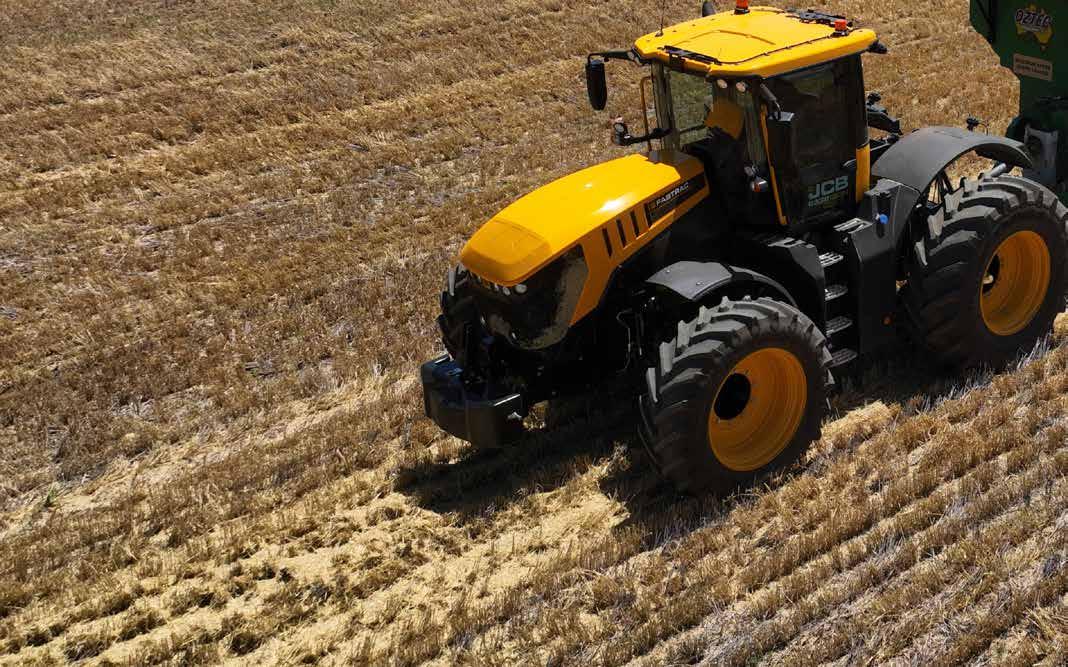

25
LIMITED STOCK AVAILABLE FOR IMMEDIATE DELIVERY! Like to know more? visit www.jcbcea.com.au or Ph: 1300 522 232 3.99%* FINANCE! HURRY OFFER VALID UNTIL 28TH JUNE 2024 p.a * Only available to ABN holders through CEA Financial Services, provided by De Lage Landen Pty Ltd ABN 20101692040. 3.99% p.a. based on 30% deposit followed by 36 monthly repayments commencing 1 month after settlement, and is only applicable to the base unit. GST paid back in month 4, no lump sum final balloon payment. Subject to credit approval, terms, conditions, and fees apply. Offer available to all new sales of JCB 4220 iCON Haulage, 4220 iCON and 8330 iCON Fastrac tractors on approved purchases retailed and delivered between the 1st of April 2024 and the 28th June 2024 through participating JCB Dealerships.

ANTON MATTHEWS BUILT HIS FIRST MULCHER IN 1990. IT HAD A 280-HP ENGINE AND THE MULCHER IN FRONT RATHER THAN AT THE REAR.
“We have pulled some kiwifruit blocks out twice, first when the arse dropped out of the industry and then during PSA. That was a lot of heartache,” Anton says.
Nowadays Anton prefers to spend whatever spare time he has on his avocado orchard, not building machines for others. But
WITH ITS MEGA 400 MULCHER, BAY MULCHING CAN CLEAR 1 HA OF LAND PER DAY OR 100 METRES OF SHELTER STUMPS PER HOUR.
that could change.
He has one staff member, Rob Hyde, and they have been working together for 17 years.
“Rob is a very handy mechanic. He came to do industrial painting for me and never left. He turns up for work every day and customers love him.”
Nowadays Rob does the mulching and chipping and Anton does the big maintenance, chases the work and is getting the avocado orchard going.
Anton and his partner Janine Henderson’s son Liam worked for Bay Mulching for three years and he still rents a flat on Anton’s Tauranga property.
“When work dropped off, Liam wanted to move on. He is a very accomplished digger operator and heavy equipment fitter, so a very handy person.”
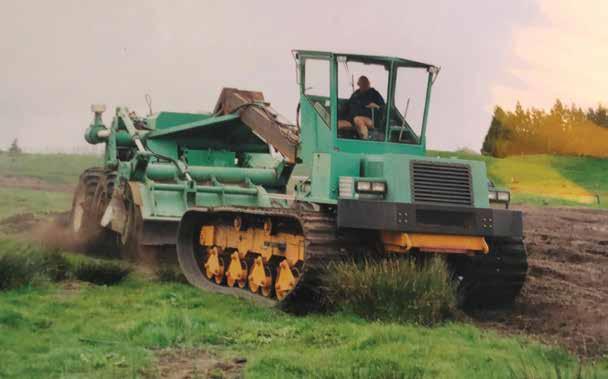
MULCHING TRENDS
The world of mulching has changed over the 30 years of Bay Mulching. Anton used to have lots of small jobs, and now it has become fewer but bigger jobs.
That is efficient, but only if there is enough work.
“It’s a lot harder out there now. With the higher interest rates, people are spending as little as possible. Also prices for avocados are less than what it costs to grow them.
“A sad outcome of the downturn in prices is that smaller blocks are being mulched. The blocks that are not economic, are worth more as lifestyle blocks.”
Anton says dairy clients are slowly coming back as prices improve, but overall it is hard being in the rural sector. Some of

WHEN ANTON MATTHEWS FIRST BUILT HIS HUGE MEGA 900 MULCHER, IT WAS TOWED BEHIND A TRACTOR AND HAD ITS OWN V12 CATERPILLAR 900-HP ENGINE.
the problem is increased compliance costs.
“Granddad had a sheep station in the 1950s in the Wairarapa. He paid for it in two years with the wool cheque. It was a pound a pound because of the Korean War.”
As Anton gets older he is getting smarter about the risks Bay Mulching takes on.
“Steep ground is more expensive and I want Rob working again tomorrow. If he thinks a job is dicey, then we don’t do it.”
Developing the avocado block in Northland started about three years ago, when Anton and Janine bought the land and planted shelter belts. Two years ago they planted 9 ha of avocados.
“At the time avocados made as much money as kiwifruit with less work. It’s changed, but it may come back.”
He says it is still a nice lifestyle, “mowing and buggering around with trees, after years of mulching them down”.
Because he has a small block, Anton cannot compete on scale, so he is aiming for quality. He’s working towards growing organic fruit with organic fertiliser and using ozonised water as a foliar spray.
“With ozone I can spray with the doors open. Ozone has been trialled in Katikati and it is working well for us so far. It seems to be keeping pests at bay on our block. We have had no bugs since October.”
PROFILE 26

^Finance under chattel mortgage with an interest rate of 0% p.a., 30% cash deposit, the GST component repaid in the 4th month and monthly repayments in arrears over a 36 months term. Available for new retail orders placed before COB 30 June 2024, and installed within two calendar months of arrival, to approved purchasers for business purposes only. Fees, terms & conditions apply. Not available in conjunction with any other offer. Finance provided by AGCO Finance Pty Ltd ABN 42 107 653 878. Offer available at participating Massey Ferguson Dealers only, while stocks last. See your local Massey Ferguson dealer now. While stocks last! ZERO HERO ON MF 4700, MF 5700, MF 5700 D & MF 6700 SERIES. MF 4700 F Y EO ? 0 P.A.^ FINANCE AVAILABLE %
what’s new in... TRACTORS 90HP+

TRACTOR MANUFACTURERS CONSTANTLY REENGINEER THEIR MACHINES AND DEVELOP NEW MODELS. ADVANCED FEATURES SUCH AS FUELEFFICIENT ENGINES, CONTINUOUSLY VARIABLE TRANSMISSIONS, FACTORY-FITTED PRECISION FARMING TECHNOLOGY, AND LARGE COMFORTABLE CABS ARE AVAILABLE ON MORE AND MORE MODELS. IN THIS FEATURE THE LEADING COMPANIES TELL US ABOUT THEIR NEW HIGH HORSEPOWER TRACTORS.
MEET THE BOSS
Valtra releases S6 Series high horsepower tractor range.
Meet ‘The Boss’. No, it’s not Bruce Springsteen, it’s the new 6th-generation S-Series tractor from Valtra. Manufactured at Valtra’s Suolahti factory, it gains a new engine, cab and transmission from the previous iteration.
“This is an exciting model and the first of our 6th generation range,” says Mark Hamilton-Manns, Product Marketing Manager for Valtra in Australasia.
“There are six models in the S6 range from 280–416hp. Power is from a new AgcoPower 8.4 litre engine which meets Stage V regulations without the need for EGR (Exhaust Gas Recirculation). Using SCR (AdBlue) and avoiding EGR improves the engine’s combustion efficiency and means the engine runs cooler.”
A single turbocharger replaces the previous twin turbo design, while the long-stroke engine develops maximum power at 1,850rpm; approximately 5%
lower revs than the previous 4th-generation S-Series. Peak torque is produced at only 1,500rpm. The most powerful S416 produces up to 1,750Nm of torque – 9% more than its predecessor, while fuel consumption is reduced by 3%. While the S416 always has maximum power and torque available, its stable mates have between 20–30hp boost for specific operating conditions where PTO, implement or transport conditions require additional power.
The ML260 CVT transmission has an upgraded hydraulic pump and heavy-duty PTO drive train. The tractor’s rear axle diameter is increased to 125mm to handle the higher torque output and ensure effective power delivery to the ground. The transmission has two operating speed ranges, for field work and transport mode. “Combining the new engine with the updated transmission increases efficiency, and fuel consumption is reduced by around 10% compared to its predecessor,” claims Mark.

28
WHAT’S NEW...
VALTRA
Common cab
The S6 Series shares a similar cab frame to Valtra’s latest N, T and Q Series models. Advantages over the previous model include improved air distribution through 12 vents at various levels around the cab.
The S6 cab is available with TwinTrac reverse drive controls, while the optional Skyview cab provides greater vertical visibility.
LED lighting is standard while various lighting upgrade packages are also available through Valtra’s Unlimited Studio.
Fully tailored with Valtra Unlimited
Valtra Unlimited customisation has proven ever more popular in recent years, with over one third of all tractors leaving the Suolahti plant having some form of Unlimited customisation. Mikko Lehikoinen, Vice President and Managing Director, Valtra explains how these are of particular benefit to high horsepower customers.
“Large farms and agricultural contractors, depend on having the right solutions to undertake advanced smart farming tasks in the most efficient way possible. Valtra Unlimited is uniquely placed to offer exactly what each business needs to farm more efficiently, more ergonomically, and with increased safety.”
Valtra Unlimited features will be available for all 6th generation S Series models. The new S Series tractors are available with Unlimited’s popular Central Lubrication System (CLS) and Central Tyre Inflation System (CTIS).
Central Tyre Inflation System is controlled via ISOBUS and displays actual tyre pressures on the SmartTouch screen. Using pre-programmed SmartTouch buttons, operators can set the
ideal tyre inflation pressures to improve rolling resistance (both in the field and on the road), reduce track depth and soil compaction. The operational benefits are manifold and include lower fuel consumption and reduced tyre wear.
New technology
The SmartTouch user interface is available with features including SmartTurn automatic headland turning. There are four turning patterns included – Part Field Mode, U-Turn, Y-Turn and K-Turn.
“Our precision farming offering meets the demands of most customers, and the SmartTouch user interface makes Valtra smart farming technology the easiest in the market. We are working on new technology features which will soon benefit our customers,” explains product marketing specialist Johan Grotell.
Strong and capable
The S6 wheelbase measures 3,092mm, some 93mm longer than the recently released Q Series tractors. Weight distribution without ballast is 45% on the front axle and 55% on the rear. Maximum gross weight is 18t, allowing sufficient ballasting on the overall platform. Its rear linkage lift capacity is 12t, while the optional front linkage is 5.8t.
Hydraulic oil requirements have not been overlooked either with the base Eco unit producing 200 litres/min at just 1,650rpm. An option of two pumps each producing 200 litres/min is available, with six ESCVs including one with flow rates up to 170 litres/min.
Lever couplers assist connecting and disconnecting, even when the system is pressurised. All hydraulic valves on the S Series have an innovative self-closing flap design that prevents dirt from entering the valve.

Of course, like most Valtras, the S6 has separate transmission and hydraulic oils. This means reduced service costs due to the long oil change intervals. Perhaps more importantly it eliminates oil contamination from shared implements damaging the transmission.
Facility investment
Valtra has invested heavily in its Finnish factory to accommodate the larger tractors and to meet growing demand across the range. A state-of-the-art paint plant entered service in August 2023. The new paint plant easily keeps pace with factory production rates. The latest painting technology ensures an optimal finish and improved access for robotised spraying to achieve better coverage.
Valtra S6 Series models and their capabilities
VALTRA Q SERIESTHINKS LIKE A PRO. WORKS LIKE A BEAST.
Valtra’s 5th generation model range is now complete with an all-new series that fits between the popular T and S Series. The Q Series, designed, engineered, and manufactured in Finland, is the ideal tractor for large farms and contractors that seek performance and integrated smart technology in the 230-305 hp range. By combining industry-leading design, high quality components and outstanding aftersales support, the Q Series has the power, intelligence, and versatility to maximise productivity while driving down costs for large farms and contractors.
The Q Series is an easy-to-use, intelligent machine built to handle the most demanding tasks with ease and efficiency thanks to the reliable 7.4 litre Agco Power engine and the industry-leading Agco CVT transmission. Operator comfort is outstanding thanks to the large comfortable cab offering great visibility, excellent suspension and the award-winning SmartTouch user interface.
The total cost of ownership of the Q Series is a key feature. Easy-to-use precision farming solutions, a powerful, robust and reliable design and excellent
29
Model Max Power at 1850 rpm (rated speed 1950 rpm) Max Torque 1500 rpm Agco Power Std Boosted 84 LXTN hp kW Nm hp kW Nm S286 280 206 1250 310 228 1400 S316 310 228 1350 340 250 1500 S346 340 250 1500 370 272 1600 S376 370 272 1550 400 294 1700 S396 400 294 1700 420 309 1750 S416 420 309 1750 420 309 1750
customer support enable Q customers to maximize their performance and ensure fuel efficiency, efficiencies in working hours, and reduced inputs. This is a winning combination that will deliver the best tractor experience for this horsepower segment.
State-of-the art driveline
The 7.4 litre engine features the biggest displacement in the market for this size tractor ensuring reliability and fuel efficiency. Maximum power is available at very low engine speeds of 1850 rpm and the maximum torque stays consistent in the range of 1000 to 1500 rpm. The long stroke engine easily generates the high power and torque that is available in the Q Series. Valtra’s EcoPower principle has been applied to the entire Q Series range, further reducing fuel consumption. Maximum driving speed is achieved with only 1500 rpm.
The transmission is easy to operate. The Q Series’ electronic transmission management automatically selects the lowest possible engine revs for the work to maintain the lowest fuel consumption and distributes the power accordingly to the hydraulics, PTO, or transmission. The driver simply adjusts the settings to whichever best suits the driver or task. With droop control the operator can change the behaviour of the tractor for even more economic or intensive operating to save either fuel or
time, depending on the customer’s cost-saving preferences.
The Q is designed at the optimum weight at 9.2 tonnes and protects the soil from compaction. The maximum gross weight is 16 tonnes which ensures a high payload. Its compact design provides a low centre of gravity making it a well-balanced and extremely stable tractor.
The Aires Suspension in combination with the long wheelbase increases the pulling force of the tractor and reduces power hopping. The grip to the ground is increased as the air suspension has a faster reaction time compared to the industry standard hydraulic suspension.
At road speeds, power is transmitted almost purely mechanically, which means fast and smooth acceleration. Both the cab and the front axle are air-suspended and they are perfectly synchronized to ensure a smooth ride in any environment and any temperature.
From Pro to Pro
Drivers will appreciate the Q Series’ all-day comfort with its air suspension, the award winning and easy-to use SmartTouch armrest, carefully designed ergonomics, market-leading visibility, and the easiest to use smart farming features on the market.
The Q Series will fit into any fleet thanks to Valtra Connect advanced telemetry and easy-touse task management enabling

smooth FMIS and Agrirouter integration. All smart farming features in the Q Series are controlled smartly and simply from the SmartTouch user interface. Task files can be stored so that it only takes a few swipes and taps to start tasks, which are fun to complete as ISOBUS features provide the most accurate and efficient outcome. In combination with Auto U-pilot, SmartTurn levels-up the Q Series’ ease-ofuse. With SmartTurn the field operating experience becomes fully automated, freeing the drivers’ attention to focus fully on the implement and task at hand. Drivers can choose between automatic turning patterns to minimize soil compaction and increase speed and efficiency.
In true Valtra form, the Q Series can be optimised even further with Valtra Unlimited. From upgrades to the cab or tractor colour to specialist adaptions

for contracting work in the field or on the road, Valtra customers can truly tailor the Q Series to their needs to further enhance productivity.
The new Q Series can be optimised with the Valtra Unlimited automatic central lubricating system that helps ensure the Q Series is always running smoothly and avoids laborious manual lubricating. Valtra’s intelligent central tyre inflation system protects the structure of the soil in the field and optimises fuel consumption on the road. Valtra Unlimited brings safety to the Q Series with new integrated LED front work lights with balanced illumination in front and to both sides. Auto beacons come on when the speed reaches 25 kmph. And when the working day is over, the follow-me-home function illuminates the yard for increased safety, as the front waist working lights stay on for a period of time when you exit the cab.
Everything about the Q Series is designed to reduce inputs, maximize yields, optimize fuel efficiency and assist customers in fulfilling regulators’ requirements, meeting their own sustainability goals, and easily report them. The Q Series comes from one of the world’s most sustainable tractor factories in Suolahti, Finland, which is run entirely on renewable energy.
Q Series production has been underway since the autumn of 2022 – the first tractors having been delivered to customers from October last year.
Information about the Q Series was revealed at the official Q Series virtual public launch event in September 2022. Visit www. valtra.com/releasethebeast to sign up. It is time to release the beast!
WHAT’S NEW... 30
KEEP AHEAD WITH KUHN
PRECISION SPREADING TECHNOLOGY
FIND OUT MORE ABOUT KUHN’S SPREADERS RANGE
THE KUHN ADVANTAGE OPTIMISE EFFICIENCY
KUHN’s regulation control technology allows users to adapt application rates, adjust speed and so much more!

THE KUHN ADVANTAGE SAVE MONEY
With KUHN’s EMC precision spreading technology.
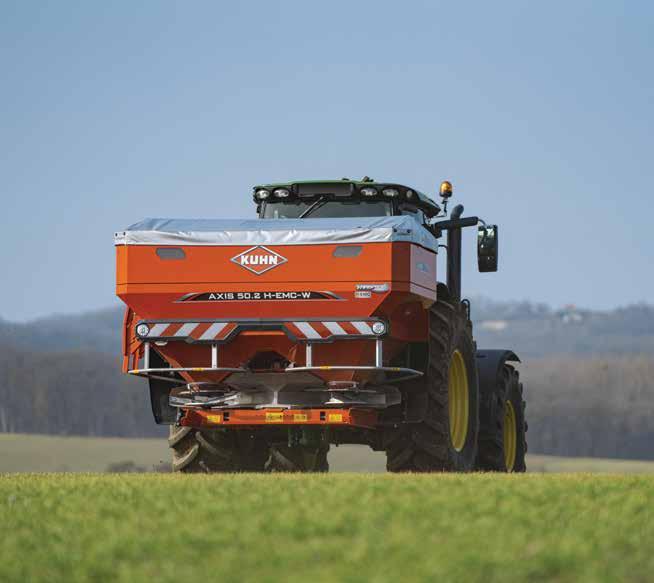

KEEP AHEAD WITH KUHN
FIND OUT MORE ABOUT KUHN’S SPRAYERS RANGE

FIND OUT MORE
TECHNOLOGY
ADAPTABLE SPRAYER
FIND OUT MORE
KUHN AUSTRALIA
KUHN AUSTRALIA
KUBOTA AUSTRALIA
M FOR MAGNIFICENT
Advances in Kubota’s MGX Series and M7 tractor range allow farmers to get the job done faster and more efficiently than ever before.
Kubota Australia’s extensive, versatile and durable tractor range enables precision and efficiency, giving farmers and contractors the peace of mind that they can tackle nearly any job.
More than 50 years of innovation has led Kubota to develop its leading MGX tractor series, the ideal choice for professional farmers, overseeing large-scale horticulture farms or smaller, mixed-farming operations.
Built for maximum power and torque output with intelligent technology, the Kubota MGX Series is equipped to efficiently handle the most demanding jobs in the field or farm.
The series includes four models, the M100GX, M110GX, M126GX and M135GX models, with engine power ranging from 100 to 135 horsepower.
The M100GX and M110GX are powered by a Kubota V3800 engine, while the larger side of the Series, the M126GX and the M135GX feature a V6108 four-cylinder, high-torque engine with a large displacement of 6.1 litres.
Senior Product Manager for Kubota Australia, Konstantin Blersch, says the MGX Series has established itself as a serious player in the utility tractor market, due to its power and durability.
“Each model in the MGX Series is equipped with Kubota’s new ‘Intelli-Shift’ transmission,” said Konstantin, “This provides the operator with eight powershift speeds, allowing for precision shifting with minimal shock and power loss.”
Featuring several sleek and innovative design elements which enhance functionality, the MGX Series boasts a tilt and telescopic steering wheel and an electric shuttle lever, making the model easy to operate.
Controls built into the righthand armrest include the hand throttle, dual engine rpm memory switch and three-point linkage controls as well as double-up powershift buttons, allowing for efficiency.
Another feature common to the MGX range, is its state-of-the-art cab and wide-opening doors, offering operators world-class comfort and stability.
Designed with the environment in mind, the MGX Series is outstanding on fuel economy, without compromising power.
“The combination of exhaust gas recirculation and the diesel particulate filter muffler reduces emissions, making the machine more fuel efficient with no sacrifice to power,” said Konstantin. “The central LCD panel monitors 26 different functions, including engine information like current engine load, fuel used per hour, hectare metre and daily performance data, giving operators peace of mind.
“The control console is user-friendly and all operating controls are intuitively within reach. It’s the perfect combination of high-tech and ease-ofuse.”
From the horticultural farms of Western Australia to the cane fields of Far North Queensland and even the dairy pastures of New Zealand, the versatility of the MGX Series makes it ideal for every climate and kind of medium-sized farming operation.
For large-scale operations, farmers and contractors can’t


look beyond Kubota’s flagship M7 tractor Series, which now includes important upgrades, making it even more suitable for Australian farming conditions.
The second generation M7-2 Series includes improved updates such as a Closed Centre Load Sensing (CCLS) hydraulic system, upgraded powershift transmission, and new electronic mapping on its 6.1 litre 4-cylinder engine, providing unparalleled performance.
The series includes three power levels, M7132, M7152 and M7172, ranging from 130 to 175 horsepower, allowing farmers to achieve productivity.
Complete with the most powerful engine in Kubota’s range, the M7-2 Series has outstanding engine performance which has been achieved by lowering both the rated engine speed and output speed.
“Improvements to our flagship engines have results in better fuel economy and very quiet engines across the board,” said Konstantin.
“And it’s not just a new and improved engine,” said Konstantin, “We listened to Australian farmers, and we know some jobs can’t be done properly at typical working speeds.
“That’s why the M7-2 Series includes a new semi-powershift transmission, providing an even greater range of 30 (+14 CREEP) forward gears, allowing farmers to find the right gear and speed for the job.”
The improved semi-powershift transmission makes the M7-2 Series ideal when working with implements.
At the top end of the M7-2 Series drive-line choices stands the Kubota KVT variable transmission with stepless speed settings from 0-50km/h.
With a rear linkage boasting a 9400kg lifting power at ball ends, the M7-2 Series comes
with plenty of muscle to safely handle large implements making it ideal for large-scale operations, from broadacre to horticulture.
Technological advances to Kubota’s M7-2 Series have seen Australia emerge as world leader when it comes to precision farming.
“We recently demonstrated the benefits of Kubota’s M7 Premium tractor and implements in a special fertiliser demonstration at Melbourne Polytechnic,” said Konstantin.
“First, we mapped the area of application using integrated satellite navigation technology to understand the outline of the field, then as the tractor moved through the field the Kubota iDC spreader automatically adjusted the application rate based on a customised prescription map created by the farmer.
“Advances like this demonstrate how innovations to our implements and tractors are saving farmers time and money. By utilising the very best of Kubota machinery, famers can save on labour costs, complete jobs more efficiently and boost on-farm productivity.”
Like the MGX Series, the M7-2 series is designed with the operator in mind. Ergonomics, quality seating and high-performance air conditioning system ensuring utmost comfort during long days in the field.
Kubota will continue to offer a free five-year warranty for all approved M7 models. The warranty offer includes the normal factory three-year warranty combined with Kubota Australia’s two year Powertrain Protection plan.
Kubota Australia dealers are right now taking orders for both the M7-2 and MXG Series. For more information, or to find your nearest dealer, visit: Kubota. com.au.
32 WHAT’S NEW...
NEW HOLLAND EXTENDS ITS T7 PLMI LONG WHEELBASE RANGE TO AUSTRALIAN MARKET
Australian farmers and contractors can expect a vastly expanded offering from New Holland’s T7 PLMi Long Wheelbase range with four distinct models available to order from April 2024.
New Holland’s revised T7 PLMi Long Wheelbase range now offers a new flagship model that delivers enhanced power and best-in-class power-to-weight ratio while maintaining the dimensions and manoeuvrability of the other models.
The new T7.300 Long Wheelbase with PLM Intelligence™ (T7 LWB PLMi) offers more power, more technology, and more comfort to maximise the tractor’s efficiency, productivity and uptime.
Ben Mitchell, Product Segment Manager for Mixed Farming & Livestock, ANZ, said the T7.300 was in response to customers wanting a tractor with more power without bigger frames and more weight, while maintaining manoeuvrability.
“We took up their challenge and developed the new T7.300 which delivers greater engine power with larger tyres for increased traction, while maintaining the same overall dimensions of the existing T7 models.
“It’s designed for operators accruing high operating hours each season, looking for an efficient and reliable all-rounder, with the latest in cutting edge technology.
“Features of the latest model include a FPT 6 cylinder engine that delivers 280hp maximum power for draft work and 300hp for Power Take-Off (PTO) and haulage tasks.
“This means farmers and contractors will be able to spend more time in the field, with an 18% increase in fuel capacity,” he said.
The T7.300 boasts an upgraded version of New Holland’s popular Auto Command™ transmission, the best-in-class driveline for tractive effort, which further adds to the tractor’s exceptional efficiency.
Integrated large square baler control’s inclusion optimises interaction between the tractor and baler, anticipating the forces exerted on the tractor by the baler, and results in a 15% reduction in cab movement, a more consistent PTO speed, and a 12% reduction in fuel consumption through the baling cycle.
“It also offers new levels of comfort, such as the Horizon™ Ultra cab, the quietest on the market with 66dBA, featuring easy-to-use technology such as the IntelliView™ 12 monitor, and the SideWinder™ Ultra fully adjustable armrest for ergonomic intuitive operation,” Ben said.
“A new Comfort Ride™ suspension coupled with the active electro-hydraulic system ‘decouples’ the cab movement from the chassis with a ‘skyhook’ control logic to deliver a supremely smooth ride.”
The T7.300 benefits from New Holland’s advanced PLM Intelligence, allowing best-in-class field applications such as Intel-
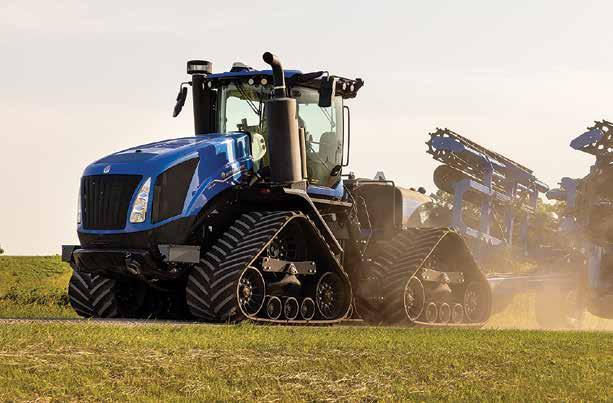
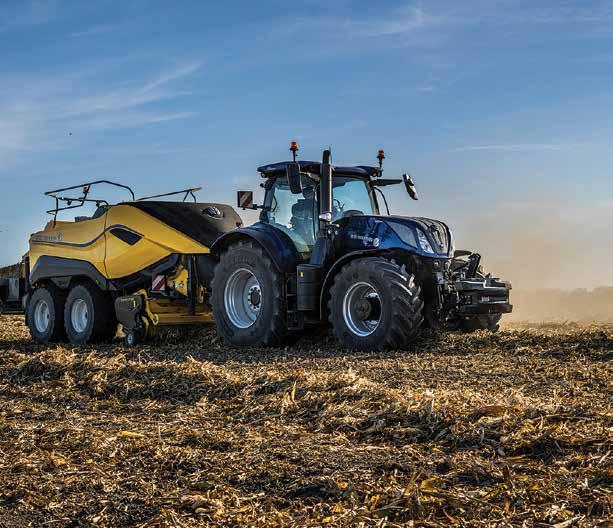
liSteer™ 1.5cm accuracy autosteering, IntelliTurn™ headland sequence management.
It is the first New Holland tractor to be fully ISOBUS Tractor Implement Management (TIM) certified, allowing two-way communication between the tractor and implement and for the implement to control the tractor.
The new T7.300, together with the expanded T7 LWB PLMi and T7 LWB Tier 3 range, was shown to the New Holland dealer network at its recent dealer conference and ‘ride and drive’ day at Lancemore, Victoria in March 2024.
Future Ag, held 17-19 of April in Melbourne, will be the first opportunity for the public to get up close and personal with the T7.300.
“New Holland now can appeal to a wide customer base with four distinct models to the market, ranging from T7 Long Wheelbase with PLM Intelligence™ to the T7 Tier 3 models,” Ben said.
“We now have a vastly expanded offering from the high hours operator wanting a ‘fully connected’ machine with all the specifications and innovations, right through to the beef cattle or dairy farmer wanting a basic tractor producing great HP to run a feed mixer.”
New Holland Reveals T9 SmartTrax™ with PLM Intelligence™ to Australian market
Australian farmers can now anticipate the T9 SmartTrax™ with PLM Intelligence™ and an enhanced, best-in-class track system having been available since March this year.
New Holland has showcased the first of its improved T9 Smart-
Trax™ with PLM Intelligence™ tractors that will be arriving on Australian shores at the end of this year.
Sales staff from New Holland dealerships from across the country gathered in the Macedon Ranges in Central Victoria for a preview of the new machines’ key features.
Marc Smith, New Holland’s Product Manager for Combine & High Horsepower Tractors, said the T9 SmartTrax™ with PLM Intelligence™ would be offered in five models for the first-time giving farmers a wider offering for a range of applications.
“Australia has a large farming footprint with many different applications that farmers face,” he said.
“The enhanced T9 SmartTrax™ models (T9.520, T9.580, T9.615, T9.655 and T9.700) will offer 475 to 645 rated horsepower options, so there is now more choice for farmers who need a lower horsepower machine for the applications they are running.
“The SmartTrax™ system offers a lot more traction with less slippage particularly in lighter soil conditions, where wheeled tractors tend to struggle.”
Improved speed and manoeuvrability are two of the biggest benefits farmers and operators will notice with the SmartTrax™ system.
“The new models will deliver an increase in top vehicle speed comparable to the wheeled models, now up to 40kmh, for quicker and more efficient field-to-field transportation,” Marc said.
“Australian farms can be spread out across kilometres, so any time that can be saved keep-
33
NEW HOLLAND
CASE IH
POWER, PRECISION AND PERFORMANCE HIGHLIGHTS OF NEW 715 HP QUADTRAC, NOW AVAILABLE IN AUSTRALIA
It’s the biggest announcement Case IH Australia/New Zealand has made around its tractor range, and it’s about to be introduced to customers around the country.
The Steiger ® 715 Quadtrac® has reached Australian shores, the brand’s most powerful Steiger ever and currently the highest horsepower tractor available in the local market.
With an engine rated for 715 continuous horsepower (527 kilowatts) and 778 peak HP, the Steiger 715 delivers ‘power with purpose’, putting more power to the ground to do more in a day, while being agile and versatile enough to navigate a single lane of traffic.
“With the arrival of the Steiger ® 715 Quadtrac®, combined with the new Steigers we launched to the local market last year, it positions the range as one of Case IH’s most flexible tractor offerings,” said Justin Bryant, Case IH ANZ Steiger Product Manager.
“This is a major, and very exciting, announcement for our brand and we’re extremely proud to finally have it here and available for Australian and New Zealand customers to order.”
Features include:
- New heavy-duty undercarriage with a longer track design for improved traction and flotation to match the tractor’s high horsepower, while still reducing soil compaction and delivering more power to the ground;
- New FPT 16L TST twin-stageturbo Tier 2 engine with 23% increase in displacement over the 13L delivering more power

ing the operation moving more efficiently between paddocks that aren’t necessarily linked together is a bonus.
“The T9 SmartTrax™ will also have multiple track belt options available with two width choices — 30-inch (76.2cm) and 36-inch (91.44cm) — again providing diversity depending on the applications farmers are running.
“The improved T9 SmartTrax™ tractors will also offer a 47% increase in fuel capacity due to

and more torque;
- Higher three-point linkage capacity and full engine power through the whole working range of that three-point linkage;
- Improved visibility from the operator’s cab with newly re-styled cab interior, redesigned bonnet and exhaust and increased LED lighting power;
- Increased road speed;
- 16-speed PowerDrive powershift transmission;
- Increased fuel capacity to allow longer stints in the paddock;
- Easier daily service with 31% greater access from re-designed engine hood, debris shields easily removed without the need for tools, giving greater access around the engine;
- Newly-designed exterior cab roof styling with integrated overhead grab rails for safe access right around the cab, powerful LED work lighting;
- State-of-the-art cab with optional dual Pro 1200 displays for increased functionality, ventilated and heated leather seat, telescoping steering wheel with memory lock, and a leather MultiControl armrest.
“This is the largest, most
powerful tractor Case IH has produced and as part of the Quadtrac family it further complements the proud history of this dynamic range which has been a leader in tractor power and efficiency since 1996,” Justin said.
“The large-scale broadacre sector of our industry has been demanding more power, and we’ve delivered with the Steiger® 715 Quadtrac ®, which is ideally suited to what these farmers need, and to our, at times demanding and challenging conditions.”
In Australia, the Steiger ® 715 Quadtrac® joins the MY24 AFS Connect Steiger model offering announced in August of last year, which includes Rowcrop Wheeled models from 425 –525HP; Wideframe Wheeled models from 555 – 645HP; Scraper models 555 – 645HP; Quadtrac models from 475 –645HP; and Rowtrac models from 425 – 525HP.
The Steiger ® 715 Quadtrac ® is about to embark on a tour of dealerships around the country, with local customers able to place orders now, for delivery beginning later this year, ready for winter cropping 2025.
For more information or order inquiries, contact your local Case IH dealer.
the inclusion of twin rear saddle tanks, with the design of the SmartTrax™ system having a lower profile on the tractor.
“Fuel capacity is now at 1,700L, which means extended run time and reduced refuelling stops that align with what we offer in our wheeled machines.”
Swinging cab entry steps are another innovative feature incorporated into the design of the T9 SmartTrax™ tractors.
The steps automatically piv-
ot as the tractor is articulated, keeping the ladder from extending beyond the tracks and allowing for safer and easier entry and exit from the cab.
The track system also streamlines maintenance and optimises belt tension by eliminating manual adjustments with its automatic track tensioning system — this update over the previous design can contribute to lengthening the lifespan of the track belt.
“Productivity is central to the T9 SmartTrax™; we’re cutting down on non-productive tractor time, like field-to-field movement and breaks to refuel, to maximise operator efficiency in the field and minimise time spent on the job,” Marc said.
The T9 SmartTrax™ with PLM Intelligence™ will be available for model year 2025 with order placement having started from March 2024 at local New Holland dealerships.
WHAT’S NEW... 34
JOHN DEERE UNVEILS MOST POWERFUL TRACTOR EVER IN ALL NEW 9RX LINEUP, INCLUDING 830 HP MODEL
John Deere has unveiled the most powerful tractor ever at the Commodity Classic in Houston, Texas, in the launch of the all new 9RX Series tractor lineup, including three new high-horsepower, four-track models.
Driven by the JD18 engine from John Deere Power Systems, the 9RX Series is made up of the 9RX 710 (710 hp), the 9RX 770 (770 hp) and the mighty 9RX 830 which delivers a market-leading 830 hp to Australian producers.
John Deere Production Systems Manager, Ben Kelly, said the 9RX range marked a new era in high-powered performance, to meet the demands of modern farming.
“With shifting weather patterns, labour shortages and growing input costs, the ability to prepare, plant and harvest rapidly and efficiently has never been more important to our customers,” Ben said.
“We are proud and extremely excited to bring the new 9RX Series to market, along with new engine and hydraulic options, new technology packages, cab updates and a suite of other Model-Year 25 updates, that will optimise operating speeds and in-field efficiency, and support farming operations in being autonomy-ready.”
New engines and hydraulic power options
The three new 9RX models will be powered by the JD18 engine from John Deere Power Systems, which is a Final Tier 4/Stage V-compliant 18-litre engine that meets emissions requirements using exhaust-gas recirculation technology without the need for Diesel Exhaust Fluid (DEF) – a market-leading feature.
In combination with the new engine, an optional, new 635 L/min triple-pump hydraulic system gives farmers the confidence to pull wider and heavier air-seeding trains over rolling ground, while still maintaining tractor and fan speed.
“These aren’t just incremental improvements, but rather defin-
ing changes in power and technology that will drive efficiency and profitability outcomes,” Ben said.
Autonomy-ready option
To help farmers prepare for autonomous operation, each of the new 9RX Series tractors will be equipped with autonomous-ready capabilities in base, allowing them to quickly and easily make the switch to fully autonomous operation in the future.
“As fully autonomous farming moves closer, we know how important it is for the investment farmers make in equipment to have true longevity as the production landscape changes –and we want the switch to autonomous to be as quick and simple as possible for our customers,”
Ben said.
“The autonomous-ready package offers the hardware and safety features we know today will be required for autonomous operations in the future.”
Key features of the package include rear implement ethernet, new visibility features, a back-up alarm, a 330-amp alternator, a brake controller and valve, and all the necessary connectors, controllers and harnesses.
CommandViewTM 4 Plus cab upgrades
The new CommandViewTM 4 Plus cab offers a 15% increase in floor space and 20% improvement in visibility from the righthand side, increasing storage capacity and comfort, while a full three degrees of motion and an isolated subframe protect operators from uneven terrain and noise.
“Covering large areas and driving a tractor for many hours a day can place strain on even the most experienced operators,” Ben said.
“The additional floor space and enhanced visibility offered by the 9RX Series means a much more comfortable work environment, including extra food and drink storage, and a clearer view.”
Advanced technology package
The new 9RX models feature industry-best technology, including the G5Plus CommandCenter™ Display and integrated StarFireTM 7500 receiver. An optional G5 Advanced technol -

ogy package with SF-RTK offers the ultimate in precision capabilities.
“The combination of the G5Plus display and the optional G5 Advanced technology package gives farmers access to virtually the entire John Deere portfolio of intelligence and productivity features,” Ben said.
“This includes AutoTrac™ Turn Automation for automated headland turns, as well as tools for more precise implement guidance and the automated creation of guidance lines.
“Importantly, John Deere Operations CenterTM and JDLinkTM connectivity delivers a complete
technology operating system to collect, manage and analyse field and machine data, anywhere and at any time, including from a mobile device.”
Farmer input bolsters design
To ensure the new lineup met the demands of those who will be putting the machines to work, John Deere also sought farmer feedback during the design process, bringing together a group of 12 people from across the globe to contribute.
Australian broadacre grain and cotton grower Simon Doolin, who heads up Doolin Agriculture at North Star in northern New South Wales, joined six Ameri-


35
JOHN DEERE
Please get in touch for more info: (03) 5625 1522, 0418 515 510
86
Roberts Crt, Drouin Vic 3818

cans and five Canadians as part of the group which travelled to John Deere facilities in the United States at various stages of the project.
“We first went to the US in 2019 when the 9RX machines were on the drawing board,” Simon said.
“They had a fair idea of what they wanted to do, but they wanted grower input before they started to build it.”
In seeking that input, no stone was left unturned.
“We sat down with the heads of all of the departments – transmission, motor, even the seat department – and they worked hard to understand what we all wanted,” Simon said.
“They asked what we thought of their existing transmissions; what we like or don’t like about
JUST WHEN YOU THOUGHT IT COULDN’T GET ANY BETTER
their motors; what sort of speeds we’re wanting to achieve; how much horsepower we need; how much hydraulic flow and how many hydraulic remotes we want; and so on.”
In July 2023, the group travelled to the John Deere testing farm in California, where they got to see the John Deere 9RX 830 for the first time.
Field testing the machine with a ripper implement attached, Simon said its performance was just as impressive as the appearance.
“We had the opportunity to put it through its paces and really see what it could do,” he said.
“They had both the new 9RX and the older model - the generation before this new modelwhich is the one we currently run
KIOTI
With an array of cutting-edge features, the new HX1402 and HX1302 tractors now deliver levels of comfort, efficiency and accuracy, marking them as class leaders of modern agriculture excellence.
The cab of the 1402 model sits on a refined cab suspension system engineered to absorb shocks and vibrations, ensuring a smooth and comfortable ride
across any terrain.
Effortless adjustment for precise control of implements is provided by the unmatched versatility of the hydraulic top link, which makes it capable of tackling any task with ease and efficiency .
The advanced LED light package provides unparalleled visibility regardless of the lighting conditions.
at home; you could get out of one and get into the other, so it was a really good comparison.”
That comparison highlighted how truly “mind-blowing” the new tractor was, Simon said.
A machine you “can’t go past”, Simon said the new 9RX would one day be added to his fleet of John Deeres, which includes several 7, 8 and 9 Series tractors, and two S Series combine harvesters – a S680 and a S780.
“Efficiency is one of the only ways we can make gains in agriculture these days, and machines with industry-leading technology are a massive part of achieving that,” he said.
It all adds up
Ben said the addition of the powerful 9RX Series lineup would lead the way in helping
farmers meet critical windows in their unique production cycles.
“For small grain farmers, the higher engine and hydraulic power means they can pull fully-loaded air seeders over virtually any type of terrain without slowing down, while the ability to pull wider implements will fast-track field preparation tasks such as deep ripping and high-speed disc tillage,” he said.
The new MY25 high-horsepower 9RX model has been available for order from mid-March for delivery in early 2025, with additional model-year updates available for 7 and 8 Series tractors.
For the latest news and product launch information from John Deere, see your local John Deere dealer.

Easy Stop technology simplifies your operations by streamlining navigation and enhancing safety with intuitive controls, making every manoeuvre effortless. Get behind the wheel and experi-
ence the HX02 Series today. For more, visit www.kioti. com.au.
36 WHAT’S NEW...
JCB AUSTRALIA
FASTRAC 8330
The latest enhancements to the Fastrac 8330 ensure it is the largest and most powerful JCB tractor yet.
Faster, more comfortable, extremely versatile and fitted with more safety features than any other tractor in its class, the Fastrac 8330 guarantees operators can get more done in a day than ever before.
With its speed, comfort, productivity, safety and versatility, the Fastrac 8330 can make a big difference to any operator. Thanks to its faster road and field speeds plus unique allround suspension, the Fastrac 8330 is a great machine for any farming operation.
Fastrac 8330’s engine combines advanced powertrain and suspension systems to deliver the ultimate in power, torque and traction making the difference in any situation. It can also achieve road speeds up to 70 kph.
An 8.4-litre, six-cylinder engine delivers up to 348 hp with twin turbochargers that give quick responses and high torque ratings across a wide range of engine speeds.
A CVT transmission with improved cruise control functions also ensures optimum use of power and torque.
On the road, the Fastrac 8330’s steering is precise and well weighted. It can provide the ultimate control when travelling at 70 kph. A Rapid Steer option reduces the lock-to-lock turn of the steering wheel by 50 percent and makes headland and other field manoeuvres quick and easy.
A road performance package is an option to provide further traction control plus a ‘hill-hold’ feature that is unique to JCB.
External brakes on the axles allow the Fastrac 8330 to consistently stop up to 15 percent quick-
er than conventional tractors.
At the same time, the hydrostatic dual steering system significantly reduces operator effort whilst meeting the safety standards for high-speed tractors.
The advanced anti-lock system (ABS) retains stability and steering while optimising braking performance on the road, on dirt tracks and in the field.
An added safety feature is Fastrac’s fail-safe system, which ensures the brakes are applied in the event of a loss of pressure. A transmission disc park brake holds the tractor securely and applies air brakes on a trailer, tanker or spreader.
Fastrac 8330’s advanced suspension quickly responds to changing loads from front- or rear-mounted implements. This distributes the load evenly across the machine.
With near 50:50 weight distribution and suspension on both axles, there is plenty of traction for heavy draft work. Rough terrain is no deterrent to Fastrac operators as the all-round suspension and air seat ensure a smooth ride during baling, spreading and spraying.
The heavy-duty axles can also be used at a track width of 3m for controlled traffic and row crop work.
JCB has designed the chassis to give plenty of options when mounting a variety of implements.
Powerful hydraulics can meet the demand of implements through five rear double-acting electric spool valves and a Power Beyond hydraulic connection.
Fastrac 8330’s powerful Cate gory III rear hitch can lift 10,000 kg to handle large capacity three-point linkage spreaders, ploughs, cultivators and mount ed drills.
Sensitive electronic draft con


trol helps the tractor maintain traction under heavy load. For added productivity operators can also use the optional Category 3N front hitch with 3500-kg capacity, external lift/lower control and optional power and lighting sockets.
Optional rear deck-mounted 900-kg or 1600-kg ballast weights provide additional traction. This load is suspended, providing additional comfort over wheel weight systems. The rear deck weights are quick and easy to fit or remove, encouraging the efficient use of ballast.
In the cab, Fastrac 8330 delivers high levels of tractor and implement control through a simple, easy to use interface. Its easy-to-use touchscreen termi-
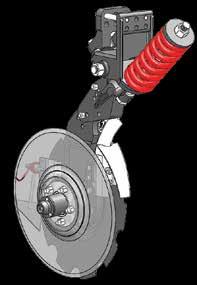

nal has large icons and intuitive navigation so operators can easily adjust settings.
Operators can also create and save up to five sequences each with up to 15 steps in the Headland Turn Assist section to minimise control workload at the end of each run across a field.
Four configurable joystick buttons can also be assigned different tasks. Factory fit GPS is available and it is compatible with a wide range of third party systems.
During spraying and spreading, the Fastrac can minimise overlap at speeds of up to 40 kph.
To find out more about the JCB Fastrac 8330 with advanced suspension, speak to your JCB CEA dealer today.

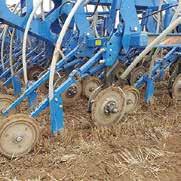
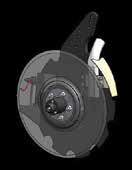
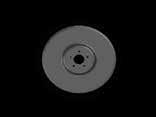



FENDT 900 VARIO MT & 1100 VARIO MT TRACK TRACTORS
The Fendt MT Vario range of track tractors spans a horsepower range of 380 hp to 673 hp and is the latest offering to the expanding lineup of Fendt products in Australia and New Zealand. The line-up combines proven innovations from Agco’s 30 years of experience in track tractors with newly engineered features that increase operator comfort and in-field performance.
“There’s nothing we haven’t thought of in creating the new Fendt Vario MT track tractors. For flotation, ride comfort, fuel efficiency, implement operation, power and reliability, these track tractors will definitely stand out as a great choice for the heaviest jobs,” says Tyron Midgley, Fendt Product Manager.
The tractors are designed to handle big crop production jobs, including medium-to-heavy high-speed tillage, as well as the largest planters and seeding implements.
“The MT Track series includes Fendt-exclusive innovations, such as a steerable three-point hitch system and a hydraulically controlled swinging drawbar option that make headland turns with large implements smoother for the operator, less demanding on the tractor and gentler on the soil.”
Fendt 1100 Vario MT
Producers looking for the power to complete their biggest jobs can choose from four models.
The 1151 (511 HP), 1156 (564 HP) and 1162 (618 HP) are powered by MAN 6-cylinder, 15.2L diesel engines. The power plant for the Fendt 1167 Vario MT (673 HP), the highest horsepower track tractor on the market today, is the MAN 6-cylinder, 16.2L diesel engine. These engines offer the Fendt iD low-rev engine concept working in unison with the Fendt Tractor Management System (TMS) and stepless VarioDrive transmission. The tractors not only provide maximum torque at 1100 rpms, they are the highest horsepower two-track tractors to offer a CVT transmission for more power to the ground and greater flotation. Fendt iD and
TMS allow the tractors to run in the maximum torque range while delivering low fuel consumption to help reduce operating costs.
The Fendt 1100 Vario MT tractors offer standard wide gauge settings of 88 to 128 inches and three track styles in three widths from 27.5 to 36 inches. A variety of engineering advances developed during 30 years of experience with tracks merge in the Fendt 1100 Vario MT tractors to deliver a new standard for traction, flotation and ride comfort from a track tractor.
The AGCO-exclusive, patented Mobil-Trac™ track system is the only mid-wheel design on the market with a suspended undercarriage and rolling midwheels. By placing the hardbar closer to the front of the tractor, engineers lengthened the wheelbase for better weight and power distribution along the belt to deliver a smoother ride and reduce compaction. These track design features, plus the widest belt offering on the market, provide better flotation to minimize yield-robbing compaction and increase return per hectare.
For even greater traction, plus more ride comfort for both field work and road travel, the Fendt 1100 MT Vario tractors feature an innovative Fendt-exclusive option, Smart Ride Plus™ load leveling. This hydraulic system for Smart Ride integrates with the front suspension springs to adjust the tractor height, keeping the chassis level to maintain the correct angle between the tractor hitch and rear implements. It also keeps the tractor level when operating heavy front- or rear-mounted attachments.
Ride comfort improves because suspension of the leveled tractor can travel equally both up and down. Finally, the self-leveling hydraulics raise or lower the front of the tractor to make attaching or removing the front mono-block weight easier. Topping off the ride-comfort features of the Fendt 1100 Vario MT tractors is two-point cab suspension with integrated shock absorbers at the rear and two shock absorbers with rubber bumpers on the front. Industry-first rear hitch sys-
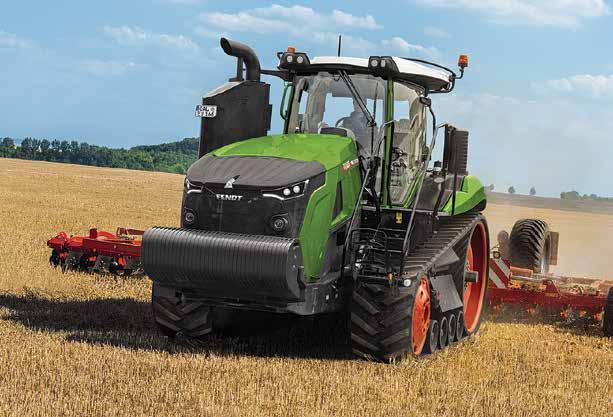
tems ease turning and soil disturbance. In addition to a standard Category 5 free swinging drawbar with 4990kg load rating, also available is the choice of two innovative hitch systems – a hydraulically controlled drawbar and a hydraulically controlled 3 point hitch. Both hitches make headland turns with large implements smoother for the operator, less demanding on the tractor and gentler on the soil. More gentle turns improve operator comfort and improve fuel efficiency.
For towed implements such as expansive planters and tillage tools, the hydraulically controlled, swinging drawbar allows the operator to guide the implement from the tractor, making contour farming, headland turns and navigating through wet fields easier. It provides 28 degrees of horizontal swing left and right, allowing the tractor to turn closer to its natural turning point under load. Auto float, fixed and offset modes give the operator total control of the implement. This hitch boasts a hefty 6800kg load rating.
The new steerable hitch system was designed with mounted implements in mind. For tractors equipped with either a standard or high-lift three-point hitch, this new system provides 12 degrees of movement in the hitch and 11.5 degrees of swing with the drawbar allowing the tractor to steer easily around contours and field obstacles without raising the implement. This hitch uses two steering cylinders to keep the drawbar in a fixed position or allow it to float with restriction. It is controlled from the tractor cab and integrated with the tractor steering for smooth turns with large implements.
High-performance hydraulics provide efficient, on-demand hydraulic power. The 1100 Vario
MT features the Fendt-exclusive dual pump, dual-circuit hydraulic system for up to 440 lpm of hydraulic oil flow. This unique two-pump system allows implements to be connected according to their oil pressure and flow requirements, high or low. It keeps full capacity on reserve until the tractor is paired with an implement with high hydraulic demands, such as a large planter. Valves are dedicated to implement control, the steerable hitch drawbar control and power beyond.
Like other Fendt tractors, the 1100 has separate hydraulic oil reservoirs for the implement and vehicle hydraulic systems, preventing cross-contamination and extending the service interval to two years or 2000 hours.
The Fendt 1100 Vario MT tractors are designed with front and chassis options for ballasting. Front weights improve machine balance, headland quality and provide correct belt-to-ground contact for the idler driver. Options include 20 or 36 suitcase weights providing up to 915kg and 1650kg, respectively, or the 2000kg mono block. Chassis ballasting on the undercarriage places weight near the machine’s center of gravity, using a combination of idler, frame and reardrive wheel weights. Weight is applied directly to the ground without putting stress on the chassis, axles or final drives to improve drawbar pull capacity.
Intuitive Fendt operation assures operator comfort. The familiar Fendt operator station makes running Fendt 1100 Vario MT tractors feel like being home. The tractor incorporates the 10.4” Varioterminal™, key machine and implement controls and multifunction joystick within the ergonomically designed armrest. The fully adjustable seat and armrest put machine
38 WHAT’S NEW...
FENDT
and implement controls at the operator’s fingertips for notable comfort during long hours in the field. The exclusive single-spoke steering wheel is ergonomic for comfortable effortless steering and offers spring-activated return-to-centre when released.
FENDT VARIO 900 MT
Fendt 900 Vario MT tractors range from 380 hp to 431 hp and are designed to operate with optimum efficiency. All systems, including the hydraulics and 2-speed PTO, run at lower engine rpm for lower fuel costs and reduced engine wear.
The Fendt-exclusive dualpump, dual-circuit hydraulic system delivers up to 440lpm of hydraulic oil flow. This unique two-pump system allows operators to connect implements according to oil pressure and flow requirements, high or low. It keeps full capacity on reserve until the tractor is paired with an implement with high hydraulic demands or until the connected implement requires additional hydraulic power. Like other Fendt tractors, the 900 Vario MT has separate hydraulic oil reservoirs for the implement and vehicle hydraulic systems, preventing cross-contamination and extending the service interval to two years or 2,000 hours.
Optional flat-face hydraulic couplers are energy-efficient and easy to connect and operate at full pressure, with minimal oil leaks during coupling, keeping the tractor, the operator and the environment cleaner. Since the system is designed to maintain pressure, oil does not heat up as
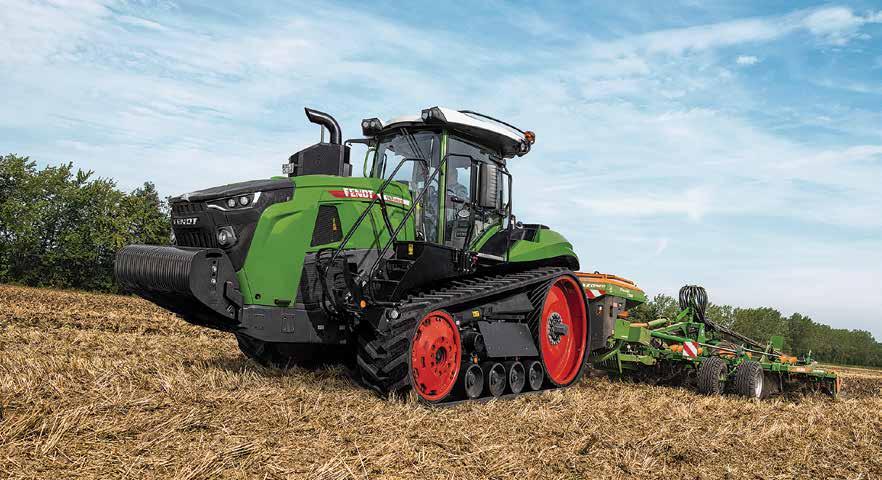
much and energy consumption for cooling is reduced.
Fendt 900 Vario MT tractors are equipped with a standard Category 3/4N three-point hitch and a 2-speed 1000 and 1000E PTO shaft. The tractors offer standard wide-gauge settings of 72 to 120 inches and three track styles in four widths from 18 to 30 inches.
Agco’s patented Mobil-trac™ system (MTS), designed with a long wheelbase for more stability, is renowned for delivering power to the ground, setting the 900 Vario MT Series apart from other track tractors in the industry. The steel hardbar acts as a front axle, attaching to the forward point of the roller frame and providing up to 11 degrees of oscillation, to improve ride and minimize compaction.
“Operators receive a noticeably different level of ride comfort when operating the 900 Vario MT tractors, especially over terraces and rough field surfaces,” Tyron says. The Smart Ride™ system combines oscillating mid-
wheels, hardbar suspension, cab suspension and seat suspension, giving operators great ride quality without sacrificing the in-field benefits of power, control and traction. The tractors also handle well at the maximum road speed of 40 kph, and ride comfort on the road is noticeably better than other track tractors.”
The oscillating mid-wheels contour to the ground over terraces and uneven surfaces, providing unmatched track-to-ground contact, improving performance and comfort.
The primary suspension has rugged coil springs and high-capacity shock absorbers for a more comfortable ride compared to hydro-pneumatic suspension systems. The two-point cab suspension system with increased suspension at the rear of the cab absorbs and dissipates the vibration from the ground through the rear axle.
Engineered for operator convenience and productivity, the Fendt 900 VARIO MT tractors
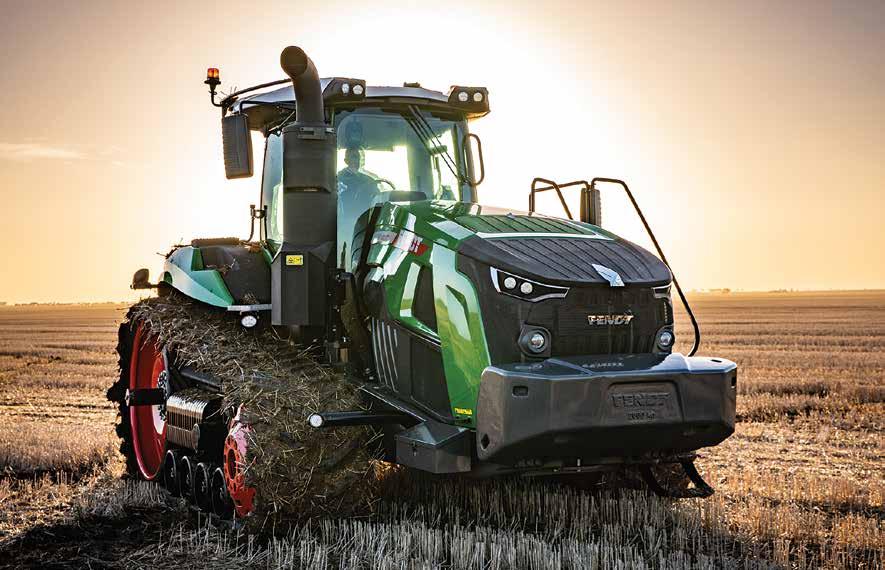
feature an easy-to-use 10.4-inch touchscreen Varioterminal™ that has an intuitive, smartphone feel. Using the Varioterminal, operators can easily manage all tractor settings and adjustments, plus monitor and control ISOBUS 11783-compatible implements, camera functions, field documentation, variable rate applications, guidance and wireless data transfer, and headland management. The Varioterminal, joystick, PTO controls and conveniently colour-coded keypad put all tasks and functions within easy reach of the operator’s fingertips for faster operation and less operator distraction and fatigue.
Owners and operators will appreciate the fit and finish of the spacious, comfortable cabs as well as the many exterior features that bring comfort and convenience to the Fendt 900 Vario MT tractors. The cabs offer a variety of amenities, including an airride seat, larger instructor’s seat and Bluetooth® capability.
An LED light package adds more lights at the rear of the tractor, positioned to provide a clear view of each end of a 24-row planter during late nights in the field.
Porch lighting on the cab provides a safe view of the area for operators leaving the field after a long day, and the battery smart-disconnect automatically powers everything down for the night.
The 900 Vario MT also has an integrated walk-around platform that provides secure, fast access for cleaning windows.
For more information about the Vario MT track tractor range from Fendt, contact your local Fendt track tractor dealer or www. fendt.com.au
39
JOHN DEERE FINANCIAL ‘THEY KNOW FARMERS’
GRIFFITH COTTON AND CEREAL GROWER AND CONTRACTOR, GAVIN DAL BROI, CLEARLY RECALLS HIS FIRST JOHN DEERE FINANCIAL APPLICATION FOR A LOAN TO BUY A SECOND TRACTOR.
He completed the application on his phone, on the couch at home and said he remembers thinking ‘That can’t be it!’. It was so easy.
“That was ten years ago when our local dealership suggested we apply for finance through John Deere Financial,” Gavin said.
“They were extremely easy to deal with, their applications were simple, and we’ve worked with them ever since to purchase all our new gear.”
‘New gear’ purchases represent a multi-million-dollar investment for Broidal Contracting, run by Gavin and his wife Clare.


Together, they operate a fleet of 17 machines providing earthworks, planting, spraying and harvesting services to farmers from southern Queensland to northern Victoria, with a team of eight employees that swells to 15 at harvest.
“We do turnkey irrigation, which is all preparation from the bare paddock right through to harvesting, so we’ve got the sprayers, planters, multiple tracked- and wheeled-tractors and cotton pickers, all financed through John Deere,” Gavin explained.
DESTINED FOR A LIFE ON THE LAND
Third generation farmers, the Dal Brois, along with Gavin’s parents, also grow cotton, corn and cereal crops on 2000ha of irrigation and 1200ha of dryland on their own properties west of Griffith – ‘Terrawarra’, ‘Warrawidgee West’ and ‘Marydale’ at Warrawidgee, in the Murrumbidgee Irrigation Area.
As a six-year-old, Gavin recalls being asked what he wanted to be when he grew up and said the piece of paper with his answer is still stuck on the fridge in his home after all these years.
‘I want to help my Dad’ the note reads with Gavin saying he just wanted to spend as much time with his father as possible.
JOHN DEERE FINANCIAL HAS BEEN VITAL TO THE SUCCESS OF GAVIN DAL BROI’S CONTRACTING BUSINESS, INCLUDING A FLEET OF 17 MACHINES AND UP TO 15 STAFF.

“I wanted to do whatever my Dad did, so that’s why I fell in love with agriculture,” he said.
“And to be honest, when you’re working 14 hours a day, seven days a week, you wouldn’t do it unless you love it.”
Gavin has worked to continually build his business skills since leaving school, completing a Diploma of Agriculture by correspondence, all while working on the family farm.
He is the current Chair of RivCott Ginning, a grower-owned business with the largest cotton cleaning and drying capacities in Australia; director of I-AG, a regionally-based software company; director of the agribusiness co-operative, Yenda Producers Group; and a pilot participant in the AgCareerStart program that encourages young Australians to work on farms.
BUILDING GOOD RELATIONSHIPS THROUGH ‘BOOTS ON THE GROUND’
The Australian agriculture industry has faced evolving challenges since Gavin was young, which feeds his commitment to adopting industry leading equipment and technology to drive his business success.
He says dealing with John Deere Financial is the best option for his operations because they know the machinery he uses and are proactive in financing new equipment as it comes to market.
“When new machinery comes to market, we’ve already been involved in discussions with John Deere Financial about payment and deposits, so it’s a seamless operation,” he said.
“They have boots on the ground and understand what we are dealing with. They’re not just a faceless entity.
“They also make our farming operation more efficient by having just a one-stop shop rather than dealing with a broker or multiple banks.”
These strong relationships have been critical during times of droughts and floods with John Deere Financial suspending repayments to support Gavin and his family during difficult operating periods.
“Thankfully, we’re only having that conversation once and with someone we have a one-on one relationship with, but even more important than that, they know farmers.”
EQUIPMENT EQUIPMENT 40
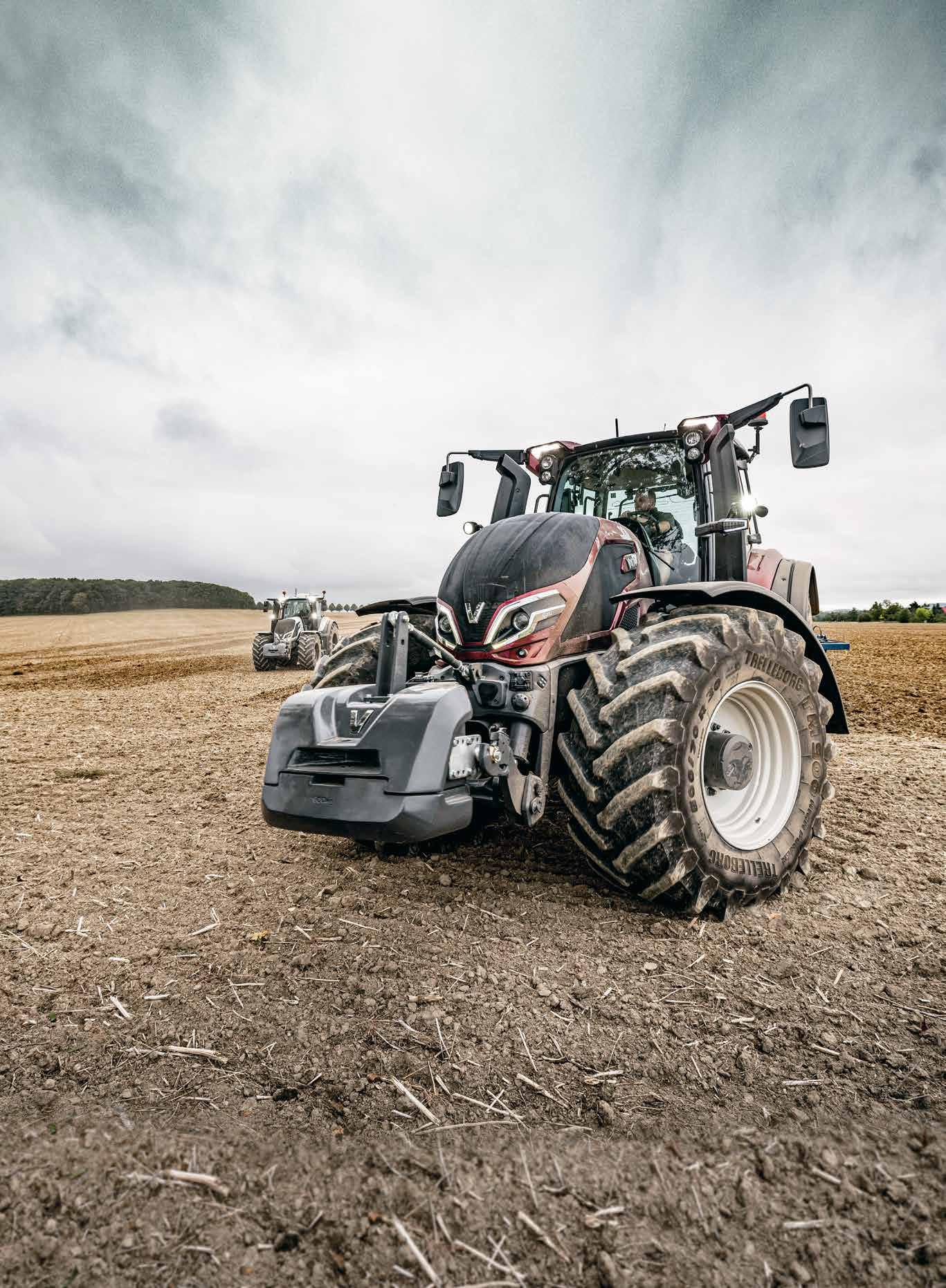
TALK TO YOUR VALTRA DEALER FOR MORE INFO TODAY. The all-new Q Series delivers power, practicality, precision and performance right on cue. Featuring intelligent design, smart technology, a 6-cylinder engine and an efficient CVT transmission, the Q series is the profitable and productive way to get the job done. 1.99% FINANCE * FOR A LIMITED TIME *Offer ends 30/6/2024, while stocks last. Finance with an interest rate of 1.99% p.a. available on a Chattel Mortgage agreement based on a minimum 20% cash deposit, the GST component repaid in the fourth month and monthly repayments in arrears over a 60 month term. Fees and lending conditions apply to approved ABN number holders who use the equipment for business purposes. Finance is approved by AGCO Finance Pty Ltd, ABN number 42 107 653 878. valtra-anz.com VALTRA ® is a worldwide brand of AGCO Q SERIES 230 – 305 HP QUALITY AND POWER TO HANDLE ANY JOB.
JOHN DEERE INTRODUCES NEW S7 SERIES COMBINE HARVESTERS
THE ACCLAIMED JOHN DEERE S-SERIES COMBINES HAVE BEEN REDESIGNED AND OPTIMISED WITH NEW TECHNOLOGIES TO BUILD ON THEIR PROVEN PERFORMANCE IN AUSTRALIAN AND NEW ZEALAND CONDITIONS AND DELIVER BEST-IN-CLASS EFFICIENCY AND PRODUCTIVITY.
John Deere Production Systems Manager, Ben Kelly, said the updates would deliver productivity gains of up to 20%, with 10% less fuel used.
“There have been visible updates to the cab and exterior styling, but the changes don’t stop on the surface,” Ben said.
“Under the bonnet, new engines will deliver more fuel efficiency, a re-designed grain loss sensing system will provide more accurate grain loss measurements, and new automation features will take operator performance to the next level.
“The S Series remains the proven workhorse it has been since its inception in 2012, but is now even better than ever.”
The new S7 Series family includes:
S7 600: 333hp/249kw rated power; 367hp/274kw max power
S7 700: 402hp/300kw rated power; 460hp/343kw max power
S7 800: 473hp/353kw rated power; 540hp/402kw max power
S7 900: 543hp/405kw rated power; 617hp/460kw max power.
NEW ENGINES, NEW GRAIN-HANDLING AND NEW RESIDUE MANAGEMENT FEATURES
The new S7 Series combine harvesters will be equipped with either the JD14 13.6L engine, or the JD9 9L engine, Tier 3 configuration. Designed to produce higher power at lower rpms, these powerhouses offer improved all-condition performance and advanced diagnostic capabilities to help keep the S7 Series running strong, all day.
“Input costs, including fuel, are one of the most challenging elements of agricultural production, while environmental and economic sustainability is central to the success of modern farm businesses, so we know the 10% fuel saving delivered by the new S7 Series will be a welcome addition to farming and contracting enterprises,” Ben said.
The S7 Series also offers a new high-efficiency residue management system. Featuring straight knives, a mechanical tailboard drive, and the available Premium PowerCast tailboard, the new machines can more consistently


size and spread fine- or extrafine cut residue up to 13.7m (45 ft.), while drawing up to 15 fewer hp (11 kw) for residue management functions.
“It’s critical for residue to be sized and spread properly to promote fast breakdown, and the residue management system on the S7 Series can be configured with a range of tailboards and knives, so growers can get the chop they need, regardless of crop,” Ben said.
A new, adjustable unloading spout ensures grain is going into the bin and not on the ground. After the grain tank is emptied, the new cross-auger shutoff feature completely empties the unloading system, reducing weight in the unloading auger and wear on the associated belts.
The new S7 Series machines also feature an improved grain loss monitoring system in base equipment.
“The new loss-sensing system detects grain loss at the rear of the cleaning shoes and the separator, and is up to three times more accurate than the previous system,” Ben said.
“The loss rate is shown clearly on the in-cab display, so operators can quickly make required adjustments.”
THE S7 SERIES: CORNER-OFFICE COMFORT
The new S7 Series has been designed to be among the most comfortable combine harvesters ever produced, with a new operator station offering more storage
A RE-DESIGNED GRAIN LOSS SENSING SYSTEM WILL PROVIDE MORE ACCURATE GRAIN LOSS MEASUREMENTS TO GROWERS.
THE NEW JOHN DEERE S7 SERIES COMBINE HARVESTER WILL INTRODUCE NEW TECHNOLOGIES TO DRIVE BEST-IN-CLASS EFFICIENCY AND PRODUCTIVITY.
space for food and drink, a more comfortable seat and more glass for better visibility – all designed to help the operator remain alert and focused through even the longest days of harvest.
Along with the operator comfort upgrades, the base S7 Series will be equipped with the G5PLUS CommandCenterTM, the Integrated StarFireTM 7500 receiver, JDLink™ modem and new corner post display, paving the way for new automation features and functionality into the future.
AUTOMATED SETTINGS HELP KEEP OPERATORS FOCUSED
The Model-Year 2025 S7 Series and X9 Series combines have three technology packages operators can choose from – select, premium and ultimate. Available options in the ultimate package include:
- Ground Speed Automation to manage the combine’s speed based on operator inputs for grain loss, engine load and rotor pressure to maintain consistent throughput.
- Harvest Settings Automation to automatically adjust rotor speed, fan speed, and concave, chaffer, and sieve clearances based upon acceptable limits for grain loss, foreign material, and broken grain. This delivers a more consistent and higher quality harvest, irrespective of operator skill level.
- Predictive Ground Speed Automation using Ground Speed
EQUIPMENT EQUIPMENT 42
PÖTTINGER VITASEM: PROVEN TECHNOLOGY WITH NEW DETAILS
MECHANICAL, PRACTICAL AND RELIABLE - THE BEST WAY TO DESCRIBE THE LATEST GENERATION OF PÖTTINGER VITASEM MECHANICAL SEED DRILLS.
To ensure the best seed emergence for all sizes of operation, Vitasem seed drills are available in working widths between 2.5 and 4.0 metres and can be teamed up with a choice of seedbed preparation machines. Varying site-specific conditions are covered by a wide range of equipment options. In terms of user-friendliness, these machines are in a class of their own.
The proven, versatile coulter systems ensure a neat seed slot for perfect seed placement in almost all operating conditions. The precise multi-metering system is driven mechanically (electric drive is available as an option) and ensures uniform metering of a wide variety of seed material.
The main focus of the facelift was to enhance output and ease of use. The hoppers on the new generation models are up to 25 percent larger. Consequently, seed capacity is greater, especially for large-grain seed and seed with little weight per volume unit. This increases the filling intervals and achieves even higher output.
SAFE FILLING
The wide opening is dimensioned to fill easily with big bags or front loader shovel. A wide
Automation as the foundation, plus two forward-looking cameras to visually assess changing crop conditions, and a pre-har-
support for sacks makes it easier to fill by hand. The wide platform provides an ergonomic and safe working environment.
MAXIMUM CONVENIENCE
Lighting inside the hopper is available in combination with floodlights on the machine to make filling easier and, above all, safer at night.
The improved calibration process sets a new standard in operating convenience. Perfect distribution across the full working width is guaranteed because the catchment trays can be viewed from the side to detect any calibration errors immediately. Pöttinger has designed the the twopart catchment trays to be pulled out to the side. All the settings and the calibration process can be carried out conveniently from the left-hand side of the machine to minimise set-up times.
CALIBRATION MADE SIMPLE
Calibration is performed mechanically as standard by turning a calibration handle. The number of rotations is displayed on the terminal.
When the final five rotations are reached, an acoustic signal sounds to alert the operator that calibration is about
vest satellite image to generate a predictive field map. The combine merges the two inputs to proactively manage ground


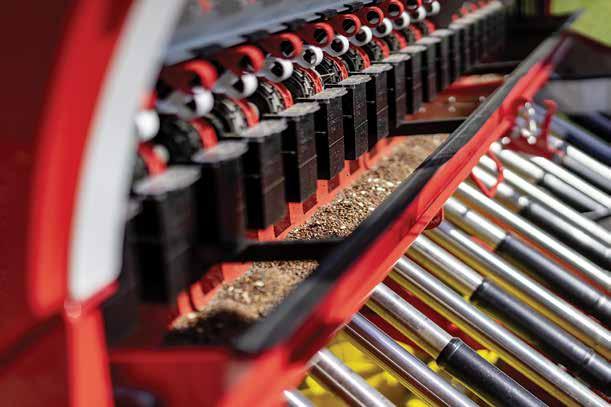
to end. Available as an option, an electric calibration system can also be installed on seed drills with mechanical metering. This makes it as easy to use as machines with electric metering drive, where the calibration process is carried out conveniently at the touch of a button.
speed and maximise combine throughput.
“These automation packages will maintain peak performance throughput all day long regardless of variations in crop yield, down crop, or even with less experienced operators, maxim-
POWERFUL ENGINES OFFER IMPROVED ALL-CONDITION PERFORMANCE AND ADVANCED DIAGNOSTIC CAPABILITIES TO HELP KEEP THE S7 SERIES RUNNING STRONG, ALL DAY.
The optional Tegosem flexible hopper is also available, allowing a second component to be distributed at the same time. This is reliably placed behind the seed coulters. Optional press wheels and levelling tines can be fitted to uniformly cover the seed material.
ising productivity at harvest,” Ben said.
“The S7 Series is one of the world’s most loved pieces of farm equipment and we are excited to introduce these new models and upgrades to deliver the most efficient, capable and operator-friendly machines we’ve ever produced for contract harvesters and growers of all types and scales across Australia and New Zealand.”
For the latest news and product launch information from John Deere, see your local John Deere dealer.
43
JOHN DEERE ANNOUNCES NEW C-SERIES AIR CART LINEUP
JOHN DEERE HAS LAUNCHED AN ENTIRE NEW LINEUP OF C SERIES AIR CARTS, INCLUDING TECH UPDATES TO THE POPULAR C650 AND C850, TO ENSURE PRODUCERS OF ALL SIZES, AND THOSE WITH CONTROL TRAFFIC FARMING (CTF) REQUIREMENTS, CAN OPTIMISE SEEDING PERFORMANCE.
Unveiled at Commodity Classic in Houston, Texas, the new models encompass a range of capacities and configurations, while offering reduced maintenance and improved seeding accuracy.
John Deere Production Systems Manager, Ben Kelly, said operations of all sizes would benefit from the new air cart technologies and multiple machine formats.
“The C650 and C850 are proven in local conditions and will now come with a suite of technological upgrades that will further enhance performance,” Ben said.
“To complement this, the range of capacity and configurations offered by the new additions to the line up will now, more than ever before, allow customers to match their cart to their farm’s needs.”
The new C-Series model numbers, capacities, configurations and tank splits include: - C350L/C350T: 12,333 L (5,638/6,695 L), leading and trailing - C400L/C400T: 14,095 L
(1,761/5,638/6,695 L), leading and trailing - C500L/C500T: 17,619 L (6,695/3,171/7,752 L), leading and trailing - C550L/C550T: 19,381 L (1,761/6,695/3,171/7,752 L), leading and trailing
- C650L/C650T: 22,905 L (1,761/9,162/4,581/7,400 L), leading and trailing - C850T: 29,953 L (1,761/9,162/4,581/14,448 L), trailing only.
REDUCED
MAINTENANCE COSTS WITH NEW CORROSIONRESISTANT ACCURATE METERS
The C Series air carts feature AccuRate electric meters constructed of stainless steel and composite materials, creating a corrosion- and wear-resistant system that stands up to seed treatments and abrasive granular fertilisers, to deliver a marked saving on meter maintenance costs.
The new AccuRate meter bank contains up to eight individually

controlled meters per tank. With the ability to change the speed and volume of each meter, customers can now run higher resolution prescriptions and have the ability to change the rate of product by each meter, allowing up to eight times more precise seed metering.
“Meanwhile, Curve Compensation gives the ability to slow an inside meter down for the insideof-a-turn and speed the outside meter up for the outside-of-aturn, leading to consistent rate delivery across the entire drill as you seed around trees and curves,” Ben said.
“The individually controlled meters also have the ability to

JOHN DEERE’S NEW LINE UP OF C SERIES AIR CARTS WILL HELP GROWERS MAKE THE MOST OF SHORT SEEDING WINDOWS.
stop each meter rotating instead of only closing the gate, which eliminates the potential for seed damage and seed dumping when turning on and off sections.”
SAVE TIME AND EFFORT WITH NEW CALIBRATION AND BLOWER AUTOMATION
To help growers make the most of short seeding windows, the C Series air carts feature two calibration features – the new industry-exclusive EZCal™ system and the trusted ActiveCal™
The EZCal system is a push-button calibration process that is completed before seeding and is now up to 75% faster than the previous manual bag process.
It can save more than 100 walking steps and eliminates the need to crawl under the cart during calibration, while ActiveCal ensures the meters remain calibrated throughout the day if
JOHN DEERE C650 AND C850 AIR CARTS WILL NOW COME WITH A SUITE OF TECHNOLOGICAL UPGRADES.
44 EQUIPMENT EQUIPMENT
FLEXCARE WITH PROFILINE COMFORT CONTROL SYSTEM
FLEXIBILITY MEETS PRECISION.
As a specialist in arable farming machinery, Pöttinger is always up to speed with optimising production methods in agriculture. The mechanical crop care range includes the Flexcare row crop cultivator that offers full flexibility working in a variety of crops. Flexcare can now be equipped with the Profiline comfort control system as an option. The Profiline comfort control system is available on all machines with up to 16 rows.
Profiline comfort control system for precision operation
With the Profiline comfort control system machines can be operated directly either using an ISOBUS tractor terminal or
other compatible control terminals. Each function is carried out immediately by pressing a button or the touchscreen.
The hydraulic oil supply is regulated by a load sensing system. This means that only the power that is actually needed is requested from the tractor hydraulics. This saves energy and increases the productivity of the tractor.
Maximum convenience
Each hoe element has a double-acting hydraulic cylinder so the hoe can be raised by tapping on the display, or controlled automatically by GPS signals at the headland and in field corners. This means less fatigue for

product properties vary whilst you’re seeding.
“The value of EZCal is getting you in the field faster with an accurate calibration starting point,” Ben said.
“This is complemented by ActiveCal which allows you to calibrate throughout the day from the cab as conditions or product density change. You don’t need to worry about overor under-metering.”
In addition, all new C Series carts feature blower automation whereby the operator can set a target blower speed from the

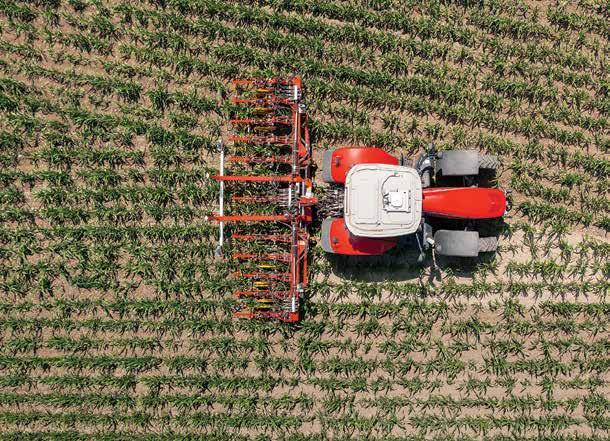
focus on the working results of the row crop cultivator.
Profiline comfort control system with Section Control
The optional Profiline comfort control system on the Flexcare can lift all the hoes at the same time at the end of the field, and allows each hoe element to be
controlled individually if the field tapers into a corner.
The weeding tools are raised and lowered with pinpoint accuracy using ISOBUS. This happens automatically when crossing the crop lanes. Ultimately, this system protects the crop, especially in wedge-shaped corners, overlaps and along field boundaries.
cab, ensuring consistent air flow as conditions change throughout the day.
“This level of automation reduces fatigue by allowing the operator to focus on the seeding task at hand, so that a quality job can be completed every time, regardless of operator experience,” Ben said.
THE C SERIES CARTS UNDER 20,000L ARE COMPLETELY NEW WITH BIG FEATURES
The needs of producers who require efficiency and produc-
tivity in smaller air carts have also been catered for in the new C Series line.
The under 20,000L air carts feature the same meters, tank scales and calibration system as their larger counterparts, with the additions of a low-profile hopper with more than double the filling space of current models; a new conveyor/auger that allows the hopper to stay in one spot while filling all four tanks, and fills up to 75% faster than the current conveyor; and the G5e cart-side display that reduces calibration time by eliminat-
ing trips between the tractor cab and the cart.
“We understand each operation has its own set of unique requirements and that has been integral to the design of the new C Series,” Ben said.
“Whether you need large or small, leading or trailing, the C Series can help operators achieve accuracy, cost efficiency and ease of use – for peak performance in the paddock.”
For the latest news and product launch information from John Deere, see your local John Deere dealer.
45
the driver, who can
* for SubScribe today FREE!
Why subscribe?
› It’s available free of charge to readers who qualify under the publisher’s criteria and who supply proof of occupation.
› All the latest news, views and information from the industry.

SUBSCRIPTION ORDER FORM
If you are not a registered reader but would like to receive a regular bi-monthly copy, please fill in the details below of your contracting or farming business and post this form to us.
Alternatively, you can fill in the subscription form on our website: www.agcontractormag.com
Australian AgContractor is available free of charge to readers who qualify under the publisher’s criteria and who supply proof of occupation (ie. printed letterhead, business card, invoice etc.) and to others upon payment of the $50.00 annual Australian Subscription (Rest of the World: $65.40 AUD).



› In-depth profiles on contractors and farmers from all across Australia.
› Six issues per year, delivered direct to your door.
› Subscriptions from as low as $50.00 annually to non-industry subscribers.
Please email admin@agrimedia.co.nz or phone +64 3 329 6555 to arrange payment if you are a non-industry subscriber.
SUBScrIBer
Name:
Business/Farm Name:
Postal Address:
Postcode:
Country:
Phone:
Email:
coNTracTor
Main contracting services offered:
Large ScaLe farMer
Criteria: Broadacre - over 1000ha and/or Sheep or Beef - over 12,000 stock units and/or Dairy - milk over 400 cows (owner or sharemilker)
Total farm ha: No. of dairy cows: No. of beef cattle: No. of sheep: Area in arable crop:
Please sign here if you wish to receive a regular copy of this publication and send the form, together with proof of occupation or cheque to: aML, Po Box 37151, christchurch 8245, New Zealand.
Signature:
Date:
www.agcontractormag.com *Australian AgContractor is available free of ChArge to readers who qualify under the publisher’s criteria and who supply proof of occupation
TYM LAUNCHES TWO NEW CABIN TRACTORS
TYM TRACTORS RECENTLY HELD THE OFFICIAL LAUNCH EVENT FOR NEW UTILITY CABIN TRACTOR MODELS
TYM T68 AND T78 AT THE MAIN OFFICE OF AUSTRALIAN DISTRIBUTOR INLON. IN ADDITION TO THE NEW TRACTORS, TYM DEALERS FROM ALL OVER AUSTRALIA WERE ALSO GETTING THEIR FIRST LOOK AT THE RECENTLY REMODELLED TS25 AND T2900HST COMPACT TRACTORS.
Inlon’s Sales & Marketing Manager Gary Surman said, “After the inevitable ‘pandemic lull’ in new production models, TYM is mak-
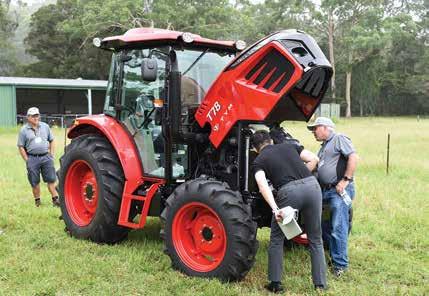

ing up for lost time with four new models released in the last six months and two more to come in 2024.
“Three representatives from TYM Korea travelled to Australia as part of a factory delegation. It was an opportunity for the delegation to speak with dealers and hear about the great customer experiences, new product ideas and needs of the Australian market.
“Starting from $20,713 (tractor only), the TYM TS25 and T2900 ROPS tractors are
market with auto throttle and HST simplifying operation. Their heavy-duty front axle, longer wheelbase and large industrial front and rear tyres give extra stability when lifting and loading.
“The new TYM T68 and T78 cabin tractors are powered by the German-built Deutz TCD 2.9 litre turbo diesel intercooled engine, which is fuel efficient, reliable and powerful with a dual dry-element air cleaner for Australia’s dusty conditions. The 4-cylinder


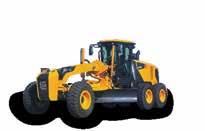



47
EQUIPMENT For further information liugongaustralia.com.au HIGH PERFORMANCE EASY MAINTENANCE BEST VALUE
of tough TOUGH WORLD. TOUGH EQUIPMENT.
A new world
SECTION CONTROL SAVINGS JUST THE START AT BOLGART
WESTERN AUSTRALIAN GROWER CURTIS GUTHRIE WAS NOT GOING TO INVEST IN A SEEDING RIG WITH SECTION CONTROL, BUT, AFTER JUST ONE SEASON ON HIS BOLGART PROPERTY LAST YEAR, HE IS SO GLAD HE DID.
Curtis farms the ‘Jingamia Farms’ property near Bolgart, plus another block to the east of the farm.
Last year, he cropped 1900 hectares to wheat, barley, canola and lupins, and the program is likely to increase another 400ha as a result of reducing sheep numbers.
The home property features heavy red loam and clay soils, as well as some non-wetting country, while the separate block comprises light, sandy soils, and, as such, significant delving, spading and clay spreading has been carried out there.
Curtis has been familiar with Morris seeding systems and last year settled on the manufacturer’s 9365 tow between air cart with Input Control Technology (ICT) for the section control, before adding a 5000-litre liquid tank to complement its two other product tanks.
Liquid delivery is managed by a Gen 5 Liquid Systems pump and full plumbing kit.
Purchased through McIntosh & Son at Wongan Hills, the air cart is hitched to a 12-metre seeding bar, which will assist a move to full controlled traffic farming in the future.
Curtis said while section control was initially not in the plans when first considering a second-hand Morris 9365 air cart, it was an important drawcard for their country.
“We have paddocks with plenty of angles and rocks and we used to seed 10 per cent more of those paddocks, whereas now with the ICT, we have reduced our overlap to only

WA GROWER CURTIS GUTHRIE, BOLGART, PICTURED WITH HIS MORRIS 9365 TOW
BETWEEN AIR CART, SAYS SECTION CONTROL TECHNOLOGY WITH THE SYSTEM HAS HELPED REDUCE OVERLAP IN SOME PADDOCKS FROM ABOUT 10 PER CENT DOWN TO ONLY 1.5PC. HE EXPECTS A QUICK RETURN ON THE INVESTMENT IN THE TECHNOLOGY AND SAYS HE IS UNLIKELY TO PURCHASE ANOTHER AIR CART WITHOUT IT.
about 1.5 per cent,” Curtis said.
“We are generally saving 6-8 per cent, and in some gnarly paddocks it is up to 10-12 per cent.”
He said the set-up with the new Morris air cart by McIntosh & Son went well and “it never missed a beat for the whole of seeding.
“Not one thing went wrong.
“The ICT is not instant on/off like with boomsprays, so there can be a slight delay. We were a little worried in spots, with stopping and starting, but we were impressed with it.
“We like to apply about 100 kilos (per hectare) of compound fertiliser, but previously we had to set the rate at 80-90 (kg/ha) so that we wouldn’t run out. Last year with the ICT, we set it at 98 (kg/ha) and we only ran out with 2ha to go, which is nothing really.”
Curtis is expecting a quick return on section control investment with the Morris air cart and said it was unlikely he would purchase another air cart without it.
“If you save 8 per cent on a 100 kilo (per hectare) rate over 1900ha, the benefit would be right up there.”
He said in addition to the section control, they now planned to vary phosphorus application rates for the coming season and would consider varying seed and Flexi-N liquid nitrogen fertiliser rates in future.
After previously driving the boomspray, last season was the first year Curtis sat in the
seeder full-time and he was also impressed with other features of the Morris 9365 air cart.
“I like the cleanout system and adjustable seed plates with this latest machine.
“We have got the two seed settings in there with canola and lupins and can make small adjustments down to our rate of about 1.8 kilos (/ha) with the canola, which is impressive. Going from lupins to the canola, you think it might affect the section control, but it doesn’t. We also had no blockages.
“The whole metering system and other parts are now stainless-steel too, which will prove its worth.”
The external boundaries of the properties are mapped and the cropping program is completed via the Topcon X35 controller, while New Holland ‘Intelliturn’ automatic end-of-row turning also is available, despite the tight paddock angles they negotiate.
The latest Morris 9365 cart offers a slightly larger capacity and with its hydraulic auger and full remote control, Curtis said it can be filled in 35 minutes.
“We do two fills a day and cover about 50ha with each fill. We have the program done by the 31st of May.”
He said the air cart and seeding bar produced their best ever canola emergence last season.
“Our canola can suffer from lodging a bit, but we noticed there was no lodging with the canola last year.”
75hp (respectively) at only 2200 engine rpm for optimal fuel efficiency.
“Importantly, the electronic engine governor holds the set engine rpm, under varying loads, delivering the maximum power of the engine when required, without rpm droops or spikes. This is ideal for PTO work, as the PTO speed is maintained without loss of rpm up to the maximum power rating. In comparison, an engine with a mechanical governor experiences rpm droops and spikes as the load varies in operation.
“Power shuttle transmission is 24 speed with 18 speeds under 10kph for the TYM T68 and 16 speed with 11 speeds under 10kph for the T78.”
Distributed Australia-wide by Inlon, the TYM T68 tractor loader package starts from $74,900.
TYM tractors are renowned for high quality, well-designed products, backed by heavy research and development investment. For more information, please visit www.tym. ag/931 or call Inlon on 1800 945 090.

EQUIPMENT EQUIPMENT
48
KUBOTA’S SVL75-3 LOADED WITH NEW FEATURES
KUBOTA AUSTRALIA HAS TAKEN INNOVATION TO ANOTHER LEVEL AS IT LAUNCHES THE SVL75-3 COMPACT TRACK LOADER, REPLACING THE PROVEN SVL75-2 WITH A RANGE OF NEW FEATURES TO IMPROVE PERFORMANCE AND COMFORT.
Constructed with enhanced technology, the loader has a new hydraulic system and an advanced multi-function operation that delivers a 15 per cent increase in productivity.
Kubota Australia Product Manager Nathan Thomas said the SVL75-3 can take on any task, whether that’s digging, dumping, grading or moving materials.
“The upgraded SLV75-3 is powered by a Kubota New Tier 4 Final Stage V engine with a nine per cent higher torque, making it one powerful piece of machinery.
“The new fully sealed onepiece pressurised cabin prevents dirt, dust, water and debris from entering your workspace and allows a clean environment for
the operator. The latest model also delivers reduced noise alongside an updated cabin tiltup design.
“Honing comfortability, the cab offers ergonomically designed controls and a front sliding window to easily enter and exit the cabin. The improved vent layout features six vents placed through the cabin for optimised heating or cooling all year round.”
The new hydraulic system features an Advanced Multifunction Valve that guarantees smooth movement of hydraulic functions.
“The SLV75-3 allows operators to manage the AUX hydraulics, bucket and loader arm at once without fear of stalling, along
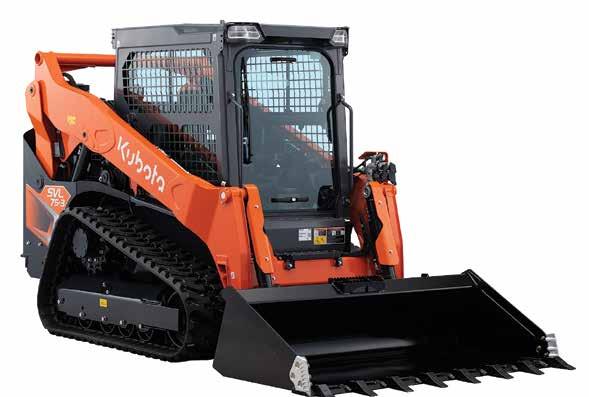
with the easy use and comfort of hydraulic pilot controls.
“The groundbreaking Electronic Travel Torque Management System is a time saver, allowing more power to quicken the pace of work.
“Users will also benefit from the updated engine and radiator layout, providing easy access to serviceable components and a new lift arm design delivering better rear-view vision from inside. Easing the load, the radiator is located conveniently on top of the engine compartment simplifying cleaning and routine maintenance.
“It also features a different airflow compared to the SVL75-2 with a standard reverse fan and

pre-cleaner as well as a larger air-cleaner.”
A new feature exclusive to the SLV75-3 is the seven-inch LCD colour monitor touch screen with jog dial.
“Championing innovation, the touch panel comes with a keyless passcode start, integrated reverse camera, radio compatible with Bluetooth and a USB port to charge your phone, making the cabin fit for a day’s work.
“The intuitive jog dial and switch is purpose built so even first-time operators can quickly navigate and access all important information.”
Nathan lauded the improved travelling performance which elevates the SVL75-3 for even the
For over 40 years, Roesners have manufactured the all purpose Marshall Multispread, designed for Australian Agriculture.
The Marshall Multispread delivers proven performance and versatility with over 11000 units in the field across Australia, backed up by superior customer service and support.
Multispread machines are available with advanced features such as the D3 spinner system for accurate spread patterns up to 36m and the i4M Variable Rate controller with loadcell weighing system and GPS auto shut-off.
To discuss your fertiliser spreading requirements, call Roesners today to speak directly to our dedicated sales, spare parts and support team.
49
FACTORY DIRECT SALES, SPARE PARTS AND SUPPORT AVAILABLE NOW
NEW ‘INTENSIVE MIX SYSTEM’ FOR STRAUTMANN FEED MIXERS
STRAUTMANN’S RANGE OF VERTI-MIX FEED MIXERS ARE WELL-KNOWN FOR THEIR STEPPED FLIGHT AUGER, WHICH DELIVERS EFFICIENT MIXING AND A UNIFORM FEED. NOW IN ITS FOURTH GENERATION, STRAUTMANN HAS INTRODUCED ITS NEW INTENSIVE MIX SYSTEM (IMS) AUGER.
Strautmann pioneered the development of the stepped auger, which better agitates, lifts and loosens the feed material for faster mixing time, uniformity and lower power requirements. With the new IMS, Strautmann has increased the number of steps, making them smaller
and more frequent. The steps now occur every 60 degrees of angle (previously 90 degrees). This accelerates the mixing process while using less power and reducing wear on the auger.
Strautmann’s patented knife adjustment system means the IMS auger can be adapted to
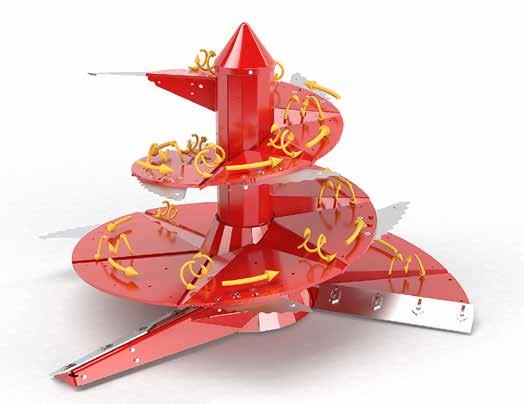
most technical loading tasks.
“Reducing travel time is a great function of the SVL75-3. An auto-shift system allows you to power through corners with an automatic downshift when turning. You can also now toggle
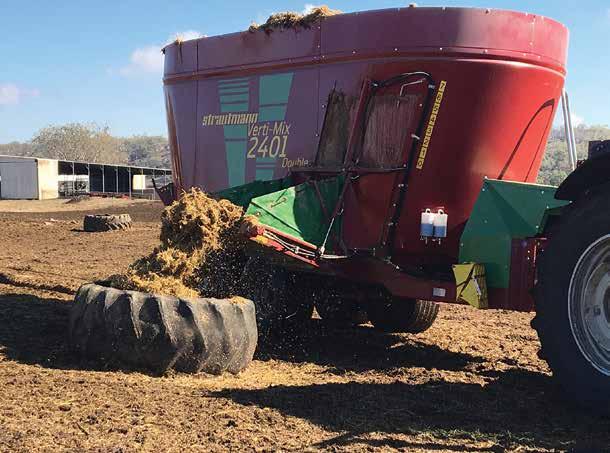
specific feed components that need an increased cutting in the mixing process, such as straw and complete round bales. The knives are available in two lengths and their working angle can be set according to whether you require aggressive cutting action or mixing. A mix of knife types and angles can be arranged along the auger flight. A special mounting position is available for the top auger knife which enables it to more aggressively and quickly break up complete bales that are loaded into the bowl.
What are the benefits of a stepped flight auger?
“The stepped design gives fast, low-horsepower mixing because the steps lift and loosen the fodder as it mixes, creating a uniform feed ration without over processing. Tests comparing traditional pure smooth spiral augers with the stepped flight auger have showed considera-
bly reduced power consumption with the stepped design,” says Andreas Haggeney, Product Manager Feed Mixing Technology at Strautmann.
Why use Verti-Mix feed mixers?
The Verti-Mix range is renowned for its speed, efficiency and uniform feed ration. Uniformly mixed feed provides better weight gain, fertility and improved feed efficiency with the potential to lower cost and wastage. From breaking up whole bales and cutting hay and straw, through to incorporating silage, grain, minerals and concentrates, Strautmann delivers every time.
The German designed and built Strautmann Verti-Mix has performed strongly in Australia for over 30 years with models from 7m3 -45m3 capacity in single, twin and triple auger configurations plus a range of discharge doors and conveyor options.
between three track responses of mild, normal or quick for a comfortable ride on any terrain.”
The SVL75-3 boasts an upgraded Kubota engine with a nine per cent increase in torque to power through any job.
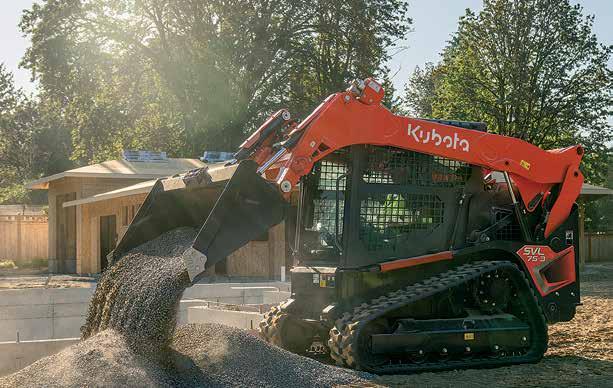
“Topping out at a dependable 74.3 hp, the new engine will let you operate with more efficiency and get the job done quicker with an increased travel speed of 13.7 kilometres.”
A new fan management system reduces power requirements in cooling, allowing the engine to operate at maximum capacity during even the most power-hungry loads. A variable fan adjusts its speed to maintain appropriate water and oil temperature.
The new arm length accommodates a tall hinge pin height of 3,117 millimetres, up from 3,025 millimetres, making it simple to load into any container or truck. A self-levelling function keeps
the bucket or fork horizontal without the need for manual adjustments.
The SVL75-3 compact track loader can carry more in less time with an increased rated operating capacity of 1,129 kilograms from the SVL75-2’s maximum of 1,043 kilograms. The new loader also has the option of a variety of attachments to tackle the most unique jobs.
“This feature heavy loader will improve your efficiency, simultaneously maximising comfort and productivity and reducing the operators load,” said Nathan.
The SVL75-3 is now available with stock beginning to arrive at dealers. Contact your local dealer to find out more.
50 EQUIPMENT EQUIPMENT
A LEGEN-DAIRY LIFE
Three hours outside of Melbourne in picturesque country, in south Gippsland, lies the lush green hills of Woorarra Dairies.
Spread across two properties with a total of around 1,400 milking cows, the dairy empire is owned and managed by brothers Steve and Matthew –the duo responsible for a farm each.
For Steve Throckmorton, it’s a busy life but he wouldn’t want it any other way.
“Farming is in my blood. I was born in Warrnambool on a sheep farm, then moved to Smithton in Tassie in 1988 with the family to work on my grandfather’s farm. That’s where I finished high school,” Steve said.
“My family moved back to Victoria in 1996 but I stayed down south for another year and worked on a dairy farm.”
These years away from the Australian mainland helped Steve hone his farming skills. Back then, he was working 250 hectares of land which was home to around 300 milking cows.
The gallons of goodness Steve helped to extract from the herds was collected and transported direct to the nearby Cadbury chocolate factory.
“It was hard work, but I learnt lots. Christmas was always a good time – there was guaranteed free chocolate nearly every year,” Steve recalled.
In 1998, Steve returned to Vic-
toria and momentarily stepped away from life on the land, taking a job as a fitter and turner. But soon enough, the country came calling.
“You can take the boy out of the country, but you can’t take the country out of the boy,” Steve said.
After nearly a decade working as a tradesman, Steve moved to Woorarra Dairy, to help his dad run the farm. It’s a family affair that continues to this day.
Today, Woorarra is home to Steve, his partner Carrie, and their two girls Kaylee and Mylah. Steve’s younger brother Mathew is always close by to ensure operations run smoothly.
“It’s a real family affair but we wouldn’t have it any other way,” Steve said.
Early morning alarms and hard work are a daily occurrence, with the dairy producing thousands of litres of milk every year.
“At our capacity, we have 600 to 700 milking cows at each farm,” Steve said.
“The good cows will be doing 50 to 60 litres of milk per day. So that averages out to about 8000 litres of milk per cow, per year.
“We usually wake up at four in the morning and are milking by five. We generally finish up around 7am, then there’s an hour of cleaning and by 3pm the same day we’re back at it, doing it all over again.”
Each day, a milk tanker rumbles


down the road to Woorarra to pick up its milk. The liquid gold is then transported to Laverton in Melbourne, where its bottled and sent straight to the supermarket shelf.
With on-farm costs rising, Steve says the past few months haven’t been without their challenges but thankfully, milk remains in high demand.
“The cost-of-living crisis has made things a bit tricky but at the end of the day, we get up and milk the cows because people love their milk. Who could blame them? It’s good for your bones!”
When he’s not milking the herd, Steve is kept busy with on-farm maintenance.
A self-confessed Kubota enthusiast, he has a collection of machinery to help keep everything in tip-top shape.
“We have a PH3600F power harrow, DSX-W Geospread fertiliser spreader, M7152 tractor and U-27 excavator, just to name a few,” Steve said.
“We like our orange here. They really do a solid job.
“The two-and-a-half-tonne U-27 excavator is good for just about everything – cleaning up,
clearing the drains, scraping the footpath, putting in water pipes and all the other little jobs.
“The M7152 tractor with the Kubota front loader is my go-to tractor. If I need to move some logs or trees or even dig a hole, it’s the one I will use every time.”
The standout of the lot is the RTV1100C side by side, which comes complete with an air-conditioned and heated cabin.
“It’s helped keep me cozy and warm on those freezing winter mornings. Now that I’m getting older, I want to be a bit more comfortable,” Steve said.
For Steve, it’s not just Kubota’s practicality and simplicity that keeps him coming back, but the friendly and professional service provided by his local dealer, Ray Massaro from Massaro Motors in nearby Morwell.
“Ray is a lovely old fella, who always gives you a thorough explanation of every machine. He’s a total professional who has become a dear friend,” Steve said.
“It’s always good to be looked after and know you’ve got the machinery you can rely on.”
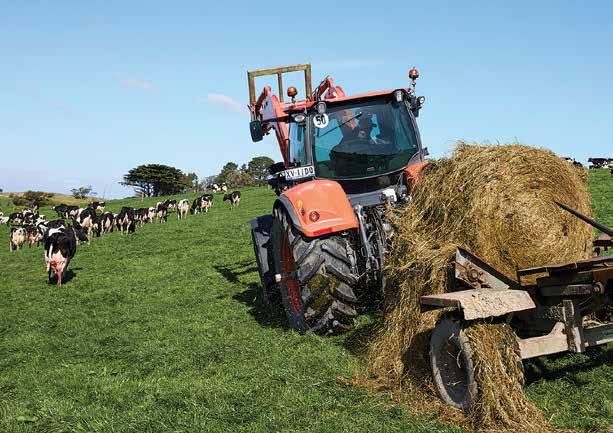
51
HOW KUBOTA HELPS DAIRY FARMER STEVE THROCKMORTON MILK THE MOST OUT OF LIFE.
KUHN’S AXIS FERTILISER SPREADER OFFERS OPERATORS PRECISION SPREADING
KUHN’S PATENTED EMC (ELECTRONIC MASS CONTROL)
TECHNOLOGY ACTS AS A WEIGHING DEVICE ON EACH SEPARATE DISC, ADJUSTING THE APPLICATION RATE LEFT, RIGHT AND EVERY SECOND.
Firstly, sensors read the torque at each disc, then, depending on the reading, the flow rate is automatically adjusted on the left- and right-hand discs.
It is the operator’s responsibility to insert the application rate (kg/Ha); everything else is done independently by the EMC to ensure the spreading rate is accurate.
With an extraordinary 100 hz adaptive regulation rate (hertz = times per second), the EMC regulation control saves operators time and money.
The CDA (coaxial distribution adjustment) technology allows operators to adapt to different variables, including different fertilisers, variable application rates, and multiple working widths. CDA has two key features that address variables, making it unique. They are:
1. A pivoting hopper base. This allows a quick adaptation to various fertilisers and working widths by adjusting the drop point of the fertiliser on the distribution discs.
2. Specially designed metering outlets close to the centre of the disc that allows multiple supply points to the blades. This ensures a constant flow of fertiliser spread in an even pattern.
Using this technology, Kuhn’s spreader machines can measure and continually adjust the application rate on each separate disc as required, ensuring accurate and effec-

tive fertiliser application, even on sloping fields and rough terrain.
Kuhn’s Lexis trailed sprayer is a high performing machine that can optimise an operator’s output, with its regulation control technology that easily adapts application rates and speeds. Lexis models come with simple, easy-to-use operator systems. The manual Mamuset operation offers operators complete control of all sprayer functions from a centralised operator station, while the Diluset+ operation means rinsing functions can be performed from inside the tractor cab; rinse the sprayer, or the boom, through an easy to use terminal from within the tractor cab. Simply program the type of rinsing required, and the automatic rinsing system will take care of the rest. The terminal can also display the volume remaining in the tank in real-time throughout the entire spraying operation.
Equipped with lightweight, bi-fold, aluminium booms, the Lexis models are less susceptible to corrosion and chemical aggression. Designed for stability with an automatic spring tilt corrector, the booms of the Lexis are integrated into the overall tank design, and fold into three parts. This compact design also limits the overall height when the booms are folded. And with a short hitchto-axle length of four meters, and a height of three meters, the Lexis machine is highly compact.
Kuhn’s range of trailed sprayers mean farmers can protect their crops with a machine to suit their needs. Whether it’s grain or multi-crop production, precision spraying is guaranteed with Kuhn’s compact designs and simple to use operator systems.
To find out more about Kuhn’s crop protection and soil preparation production, visit: https://www.kuhn.com.au/crop.

EQUIPMENT EQUIPMENT 52




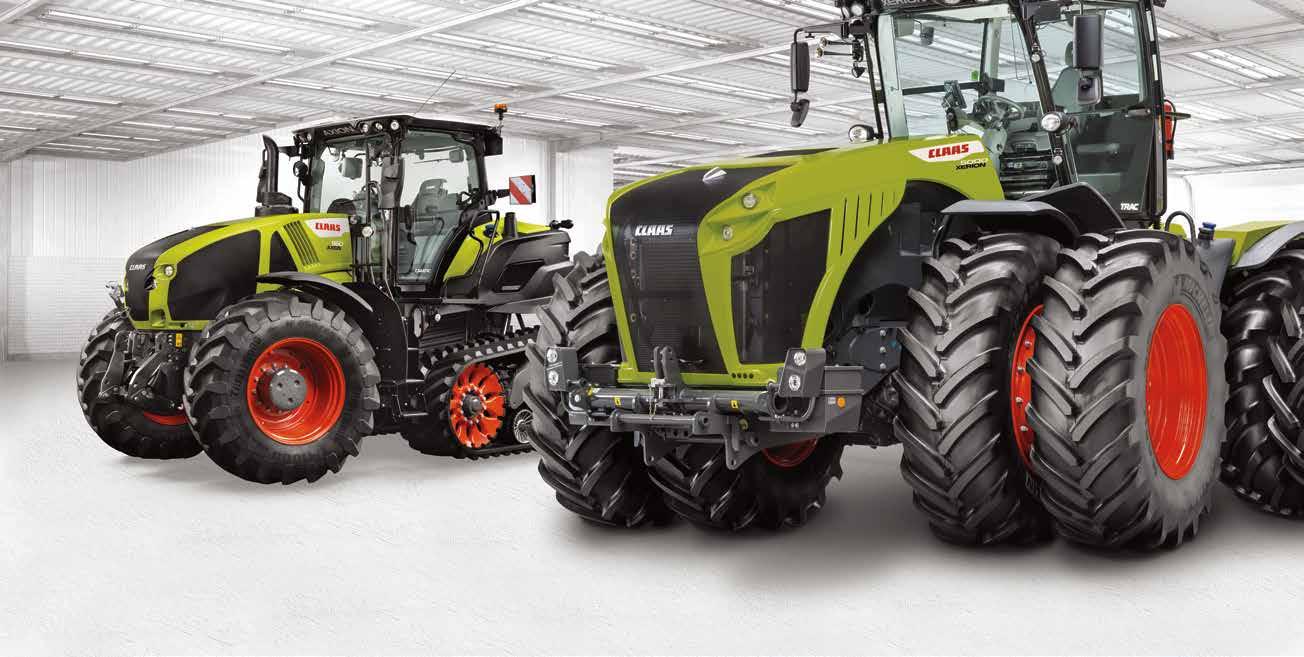
Find your local dealer at claasharvestcentre.com Tailored finance options and demos available Standard CLAAS Financial Services lending criteria, terms, and conditions apply. Machinery subject to availability. Images illustrative only. CLAAS AXION 900 | CLAAS AXION 900 TERRA TRAC | CLAAS XERION 5000 WHERE MUSCLE




















 SCOTT WILSON
SCOTT WILSON














































































































































































































































































































